Slovenia captured our hearts in just eight unforgettable days. From the emerald-green waters of Lake Bled to the breathtaking Škocjan Caves and the sun-soaked coastal charm of Piran, this small yet stunning European gem offers a perfect mix of natural wonders, rich history, and vibrant culture. In this guide, we share our detailed 8-day Slovenia road trip itinerary, featuring must-visit attractions like picturesque lakes, majestic gorges, medieval castles, and charming coastal towns. Whether you’re planning your first visit or seeking inspiration to discover Slovenia’s top destinations, this itinerary is your ultimate guide to experiencing the best of Slovenia. Let’s embark on this enchanting journey together!
Table of Contents
- Getting to Know Slovenia
- Our Itineraries
- With More Time
- With Less Time
- Other Frequently Asked Questions
Getting to Know Slovenia
Quick Facts
- Capital City: Ljubljana
- Population: Approximately 2.1 million
- Language: Slovenian (official); English is widely spoken
- Currency: Euro (€)
- Geography: Located in Central Europe, bordered by Austria, Italy, Hungary, and Croatia; features the Julian Alps, Adriatic coastline, and extensive karst topography.
- Best Time to Visit: Late spring (May-June) or early autumn (September-October) is the best time to visit Slovenia because of the mild weather and fewer tourists.
- Safety: Slovenia is considered very safe for travelers, with low crime rates and friendly locals.
A Brief History of Slovenia
Slovenia’s history is a story of cultural crossroads and resilience, shaped by its central position in Europe. Inhabited since prehistoric times, the region was part of the Roman Empire, with important settlements like Emona (modern-day Ljubljana). After the fall of Rome, Slavs settled in the area, shaping Slovenia’s language and identity.
During the medieval period, Slovenia became part of the Holy Roman Empire and later came under Habsburg rule, which lasted until World War I. Afterward, it joined the Kingdom of Serbs, Croats, and Slovenes, which became Yugoslavia. Following World War II, Slovenia enjoyed relative autonomy as a republic in socialist Yugoslavia.
After gaining independence in 1991, it emerged as a peaceful and prosperous nation. Now part of the EU and Schengen Zone, Slovenia is known for its rich heritage, natural beauty, and sustainable innovations. Walking through its cities and countryside, we could feel the layers of history come alive in every corner.
Why Visit Slovenia?
Slovenia is a captivating destination that seamlessly blends breathtaking natural landscapes, rich cultural heritage, and charming towns. From its pristine alpine lakes and towering peaks to centuries-old castles and lively cities, Slovenia offers something for every traveler, making it one of Europe’s best-kept secrets.
During our journey through Slovenia, one thing that truly stood out was how immaculately preserved everything felt. Whether strolling the picturesque streets of Ljubljana, admiring the emerald waters of Lake Bled, or hiking the stunning trails of Vintgar Gorge, every place exuded a sense of care and pride. The warm hospitality of the Slovenian peoplemade our trip even more memorable. Locals greeted us with genuine kindness, whether at bustling city cafés or cozy countryside inns, creating a welcoming and relaxed atmosphere wherever we went.
What left us in awe was the incredible diversity of landscapes packed into such a small country. In just eight days, we explored alpine lakes, walked through dramatic gorges, marveled at the world-renowned Škocjan Caves, and unwound along the sun-soaked Adriatic coast. Each day brought unique experiences—from discovering the ancient streets of Piran to enjoying panoramic views from Ljubljana Castle. Slovenia’s layered history, shaped by Roman, Slavic, and Habsburg influences, added depth to every destination, making each stop not only beautiful but also meaningful.
Slovenia isn’t just a destination—it’s an experience that stays with you. Whether you’re drawn to its natural wonders, rich history, or the warmth of its people, Slovenia offers an unforgettable journey. It’s a place we fell in love with at first sight and one we’d return to in a heartbeat.
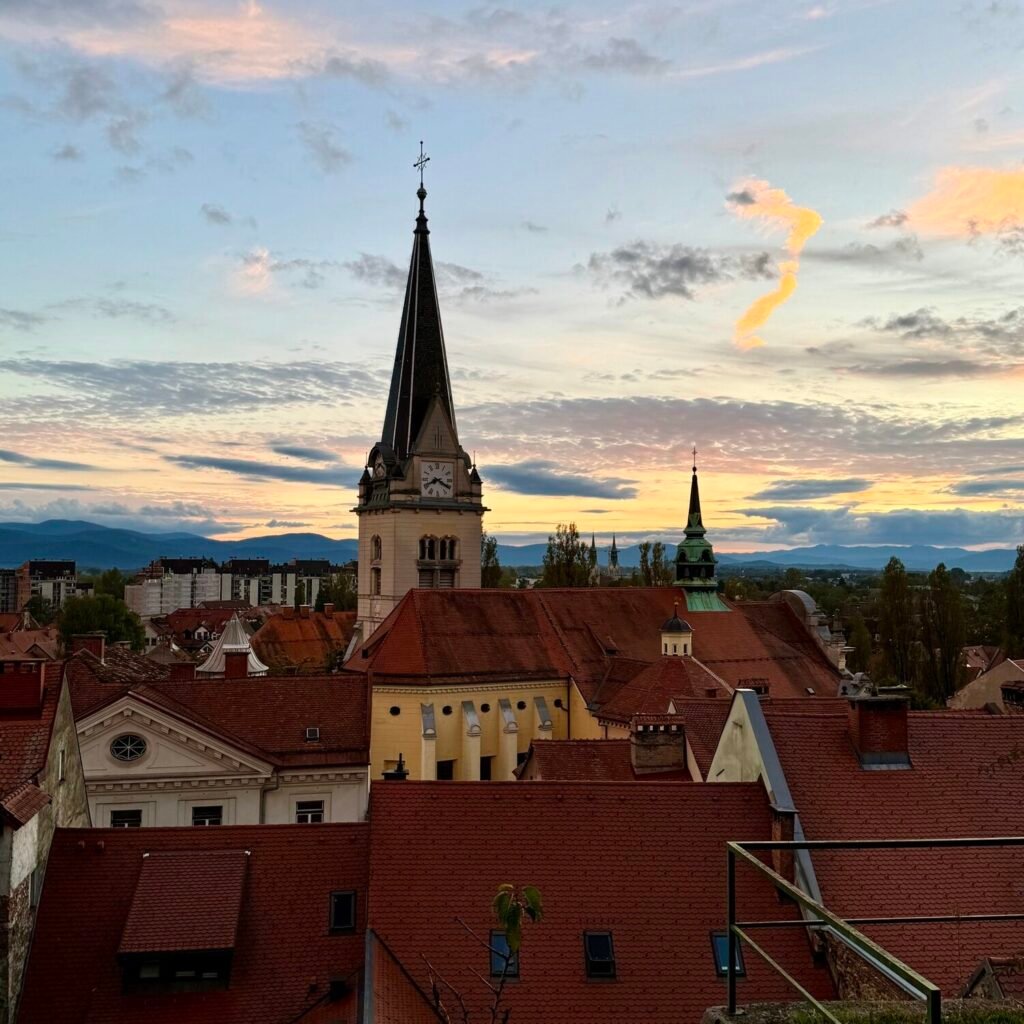
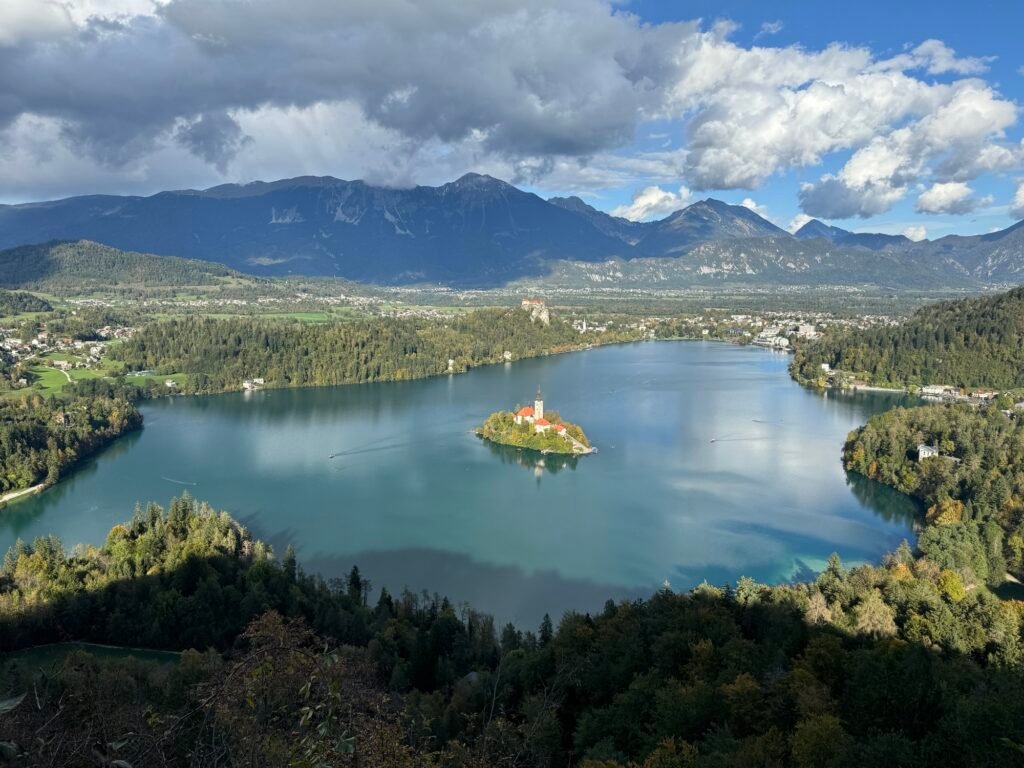
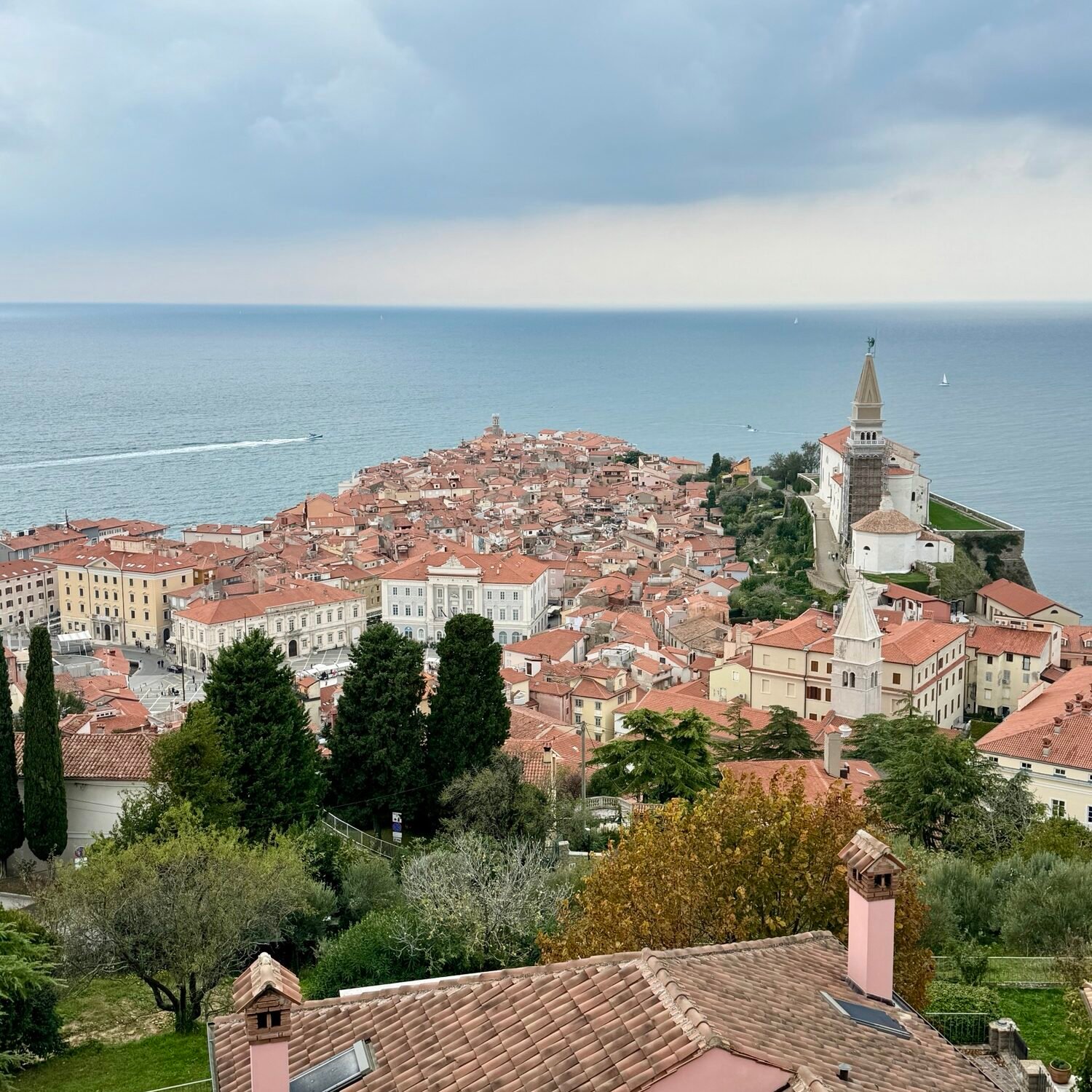
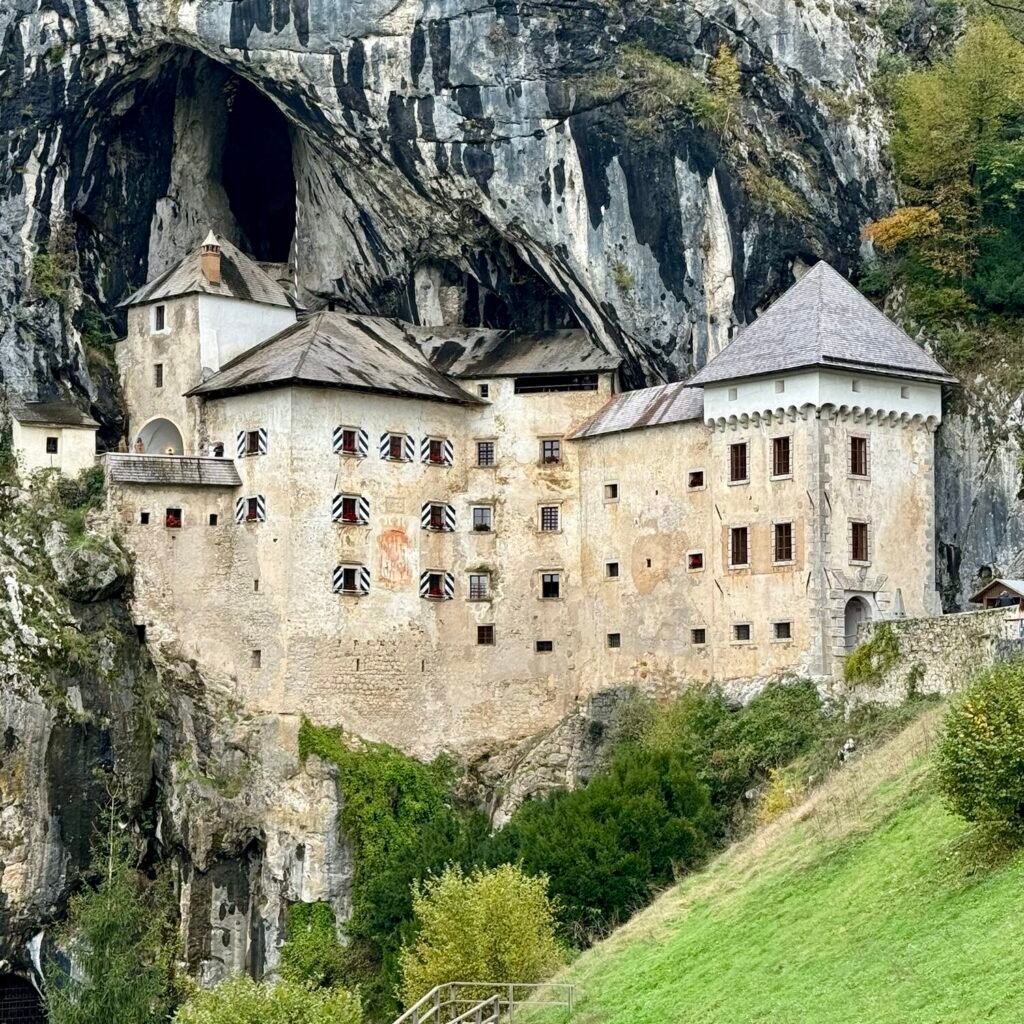
Our Itineraries
8-Day Slovenia Road Trip Itinerary
- Day 1: Arrival in Ljubljana
- Day 2: Exploring Ljubljana
- Day 3: The Magic of Lake Bled
- Day 4: Exploring Vintgar Gorge and Rediscovering Lake Bled
- Day 5: Serenity at Lake Bohinj
- Day 6: Journey to Škocjan Caves and Smarje
- Day 7: Exploring Piran and Relaxing by the Adriatic
- Day 8: Exploring Predjama Castle and Farewell to Slovenia
This itinerary is designed as a road trip, which we believe is the best way to fully experience the beauty and diversity of Slovenia.
If you’re traveling to Slovenia and want to save time searching for directions to all the places we mention in this 8-Day Slovenia Road Trip guide, look no further than our custom map. Simply click on a point on the map below to get directions there!
Day 1: Arrival in Ljubljana
Our journey began in Ljubljana, Slovenia’s charming capital. From the moment we arrived, the city’s vibrant yet relaxed energy set the tone for the days ahead.

What To Do In Ljubljana
We arrived in Ljubljana in the early afternoon. After settling into our accommodation, we had a delightful lunch at a cozy local restaurant near city center. Feeling recharged, we headed to Ljubljana Castle, perched on a hill overlooking the city. The castle can be reached via a scenic funicular or on foot. We chose to hike up, enjoying a peaceful trail that wound through the greenery. Once at the top, we were rewarded with breathtaking panoramic views of the city and its surrounding mountains. The castle itself was a treasure trove of history, with fascinating exhibits that provided an excellent introduction to Slovenia’s past. Strolling through its courtyards and climbing the watchtower made us feel as though we’d stepped back in time.

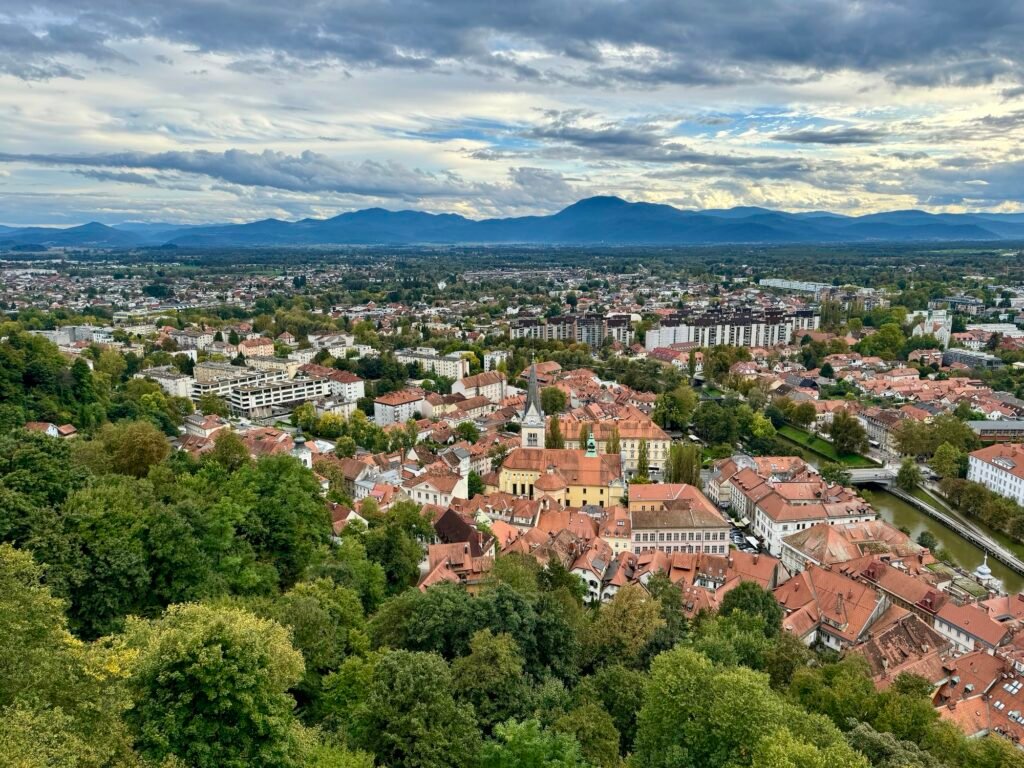

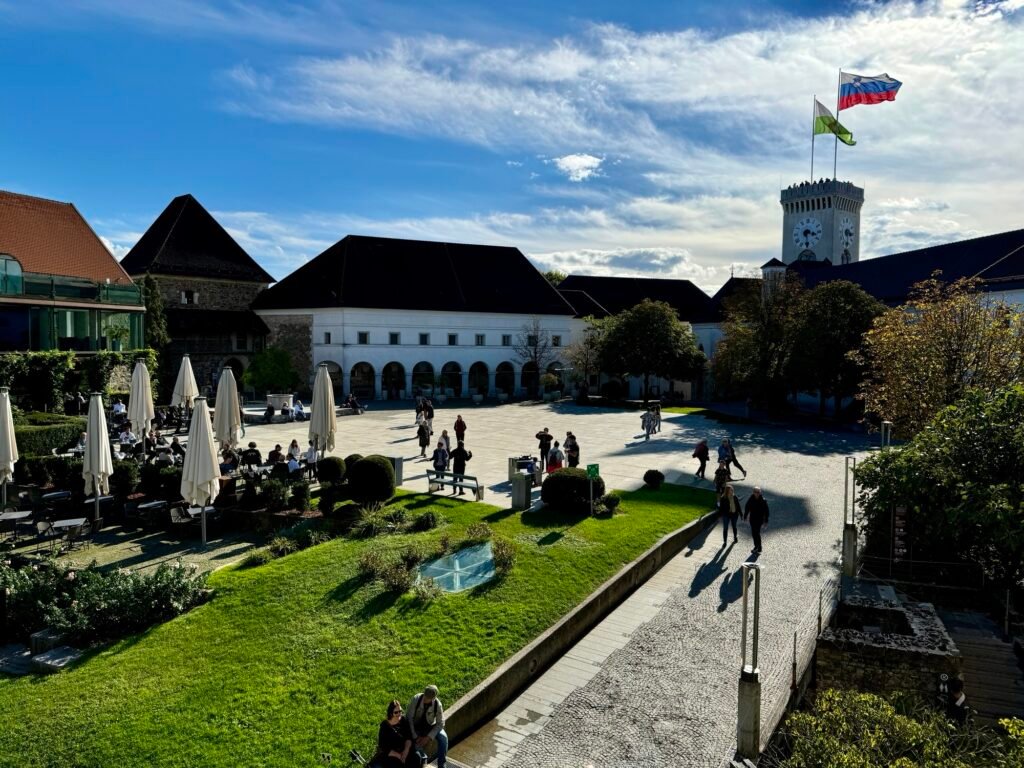

Where To Eat In Ljubljana
- Lunch: Gostilna Vida – Lovely restaurant offering fresh and delicious Mediterranean and Asian fusion dishes, including many vegan and vegetarian options. The atmosphere, music, and service were excellent.

- Dinner: Patrón Tacos & Bar – A lively modern fusion taco shop with creative takes on Mexican cuisine.

- Dessert: Gelataria Romantika – Delicious gelato with unique flavors and a charming interior. We shared a three-flavor cup with fig cream, hazelnut, and 72% dark chocolate—all of which were heavenly, with a delightfully chewy texture.
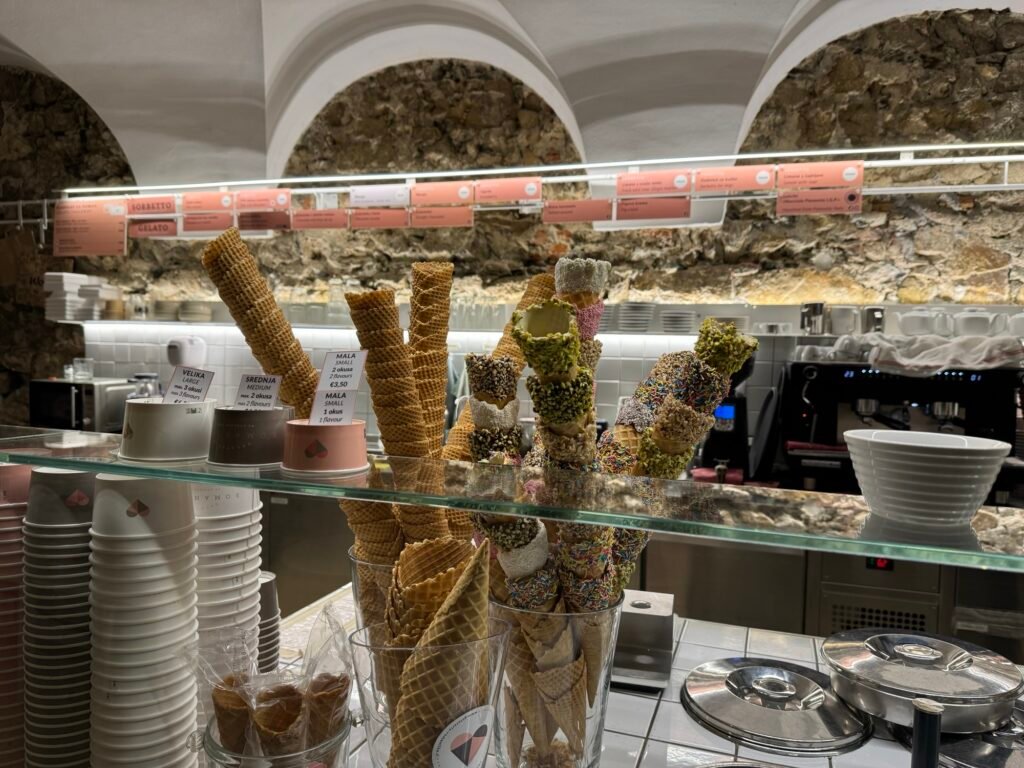
Where To Stay In Ljubljana
We stayed at a centrally located Airbnb apartment in a residential neighborhood of Ljubljana. It gave us a taste of local’s life while providing easy access to the city’s attractions.

Travel Tips For Visiting Ljubljana
Ljubljana is compact and highly walkable. Public transport is available, but you likely won’t need it for your first day of exploration.
Day 2: Exploring Ljubljana
We dedicated our second day to delving deeper into Ljubljana’s charm, balancing iconic sights with hidden gems.

What To Do In Ljubljana
Our morning began with a peaceful stroll through Tivoli Park, the largest park in Ljubljana. The park’s blend of sculptures, historical buildings, and lush green spaces made it a perfect place to relax and immerse ourselves in the local vibe. We hiked up Rožnik Hill, where the beautiful Church of Virgin Mary’s Visitation is located, and then descended to a cozy spot in the park for lunch.
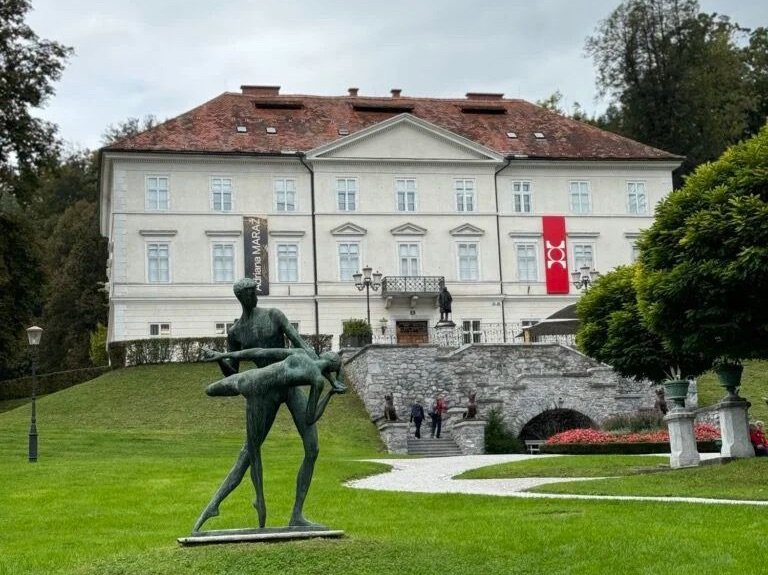

In the afternoon, we joined a guided Ljubljana walking tour led by a delightful local guide who turned out to be the first Slovenian woman to visit the North Pole—a fascinating storyteller. The tour took us through Old Town, where we explored Prešeren Square and admired the Statue of France Prešeren, Slovenia’s greatest poet. We visited the Cathedral of St. Nicholas, a Baroque masterpiece with stunning frescoes and intricate carvings. The Ljubljanica River area was another highlight, with its iconic Dragon Bridge, Triple Bridge, Shoemaker Bridge, and vibrant riverside cafes and markets. At the Central Market, we sampled honey liquor, nuts, bear meat purée (yes, really!), and fresh milk from a “milk vending machine.”
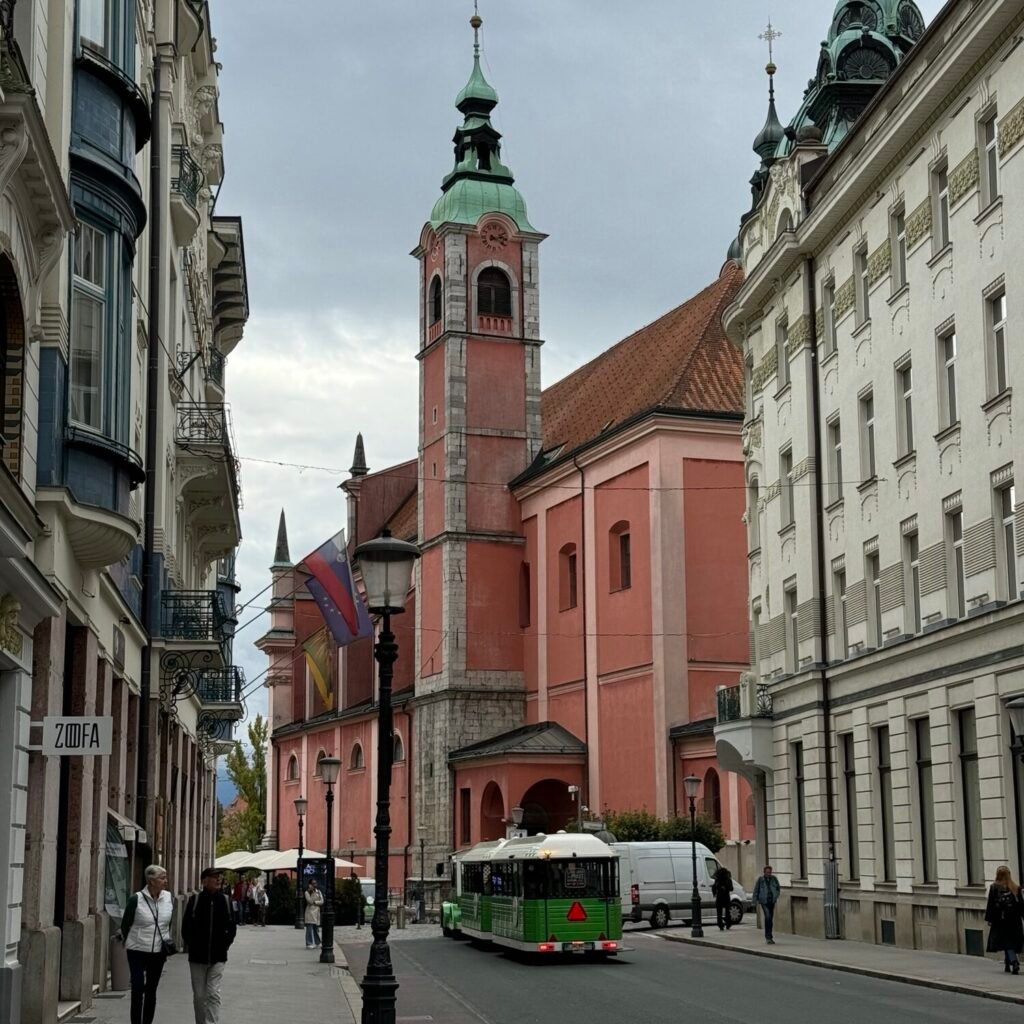
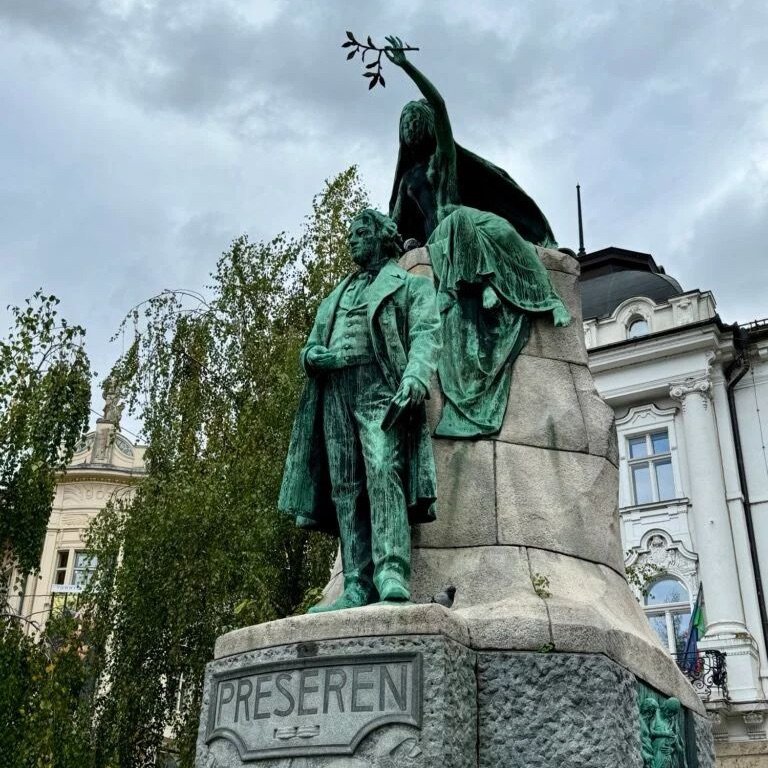

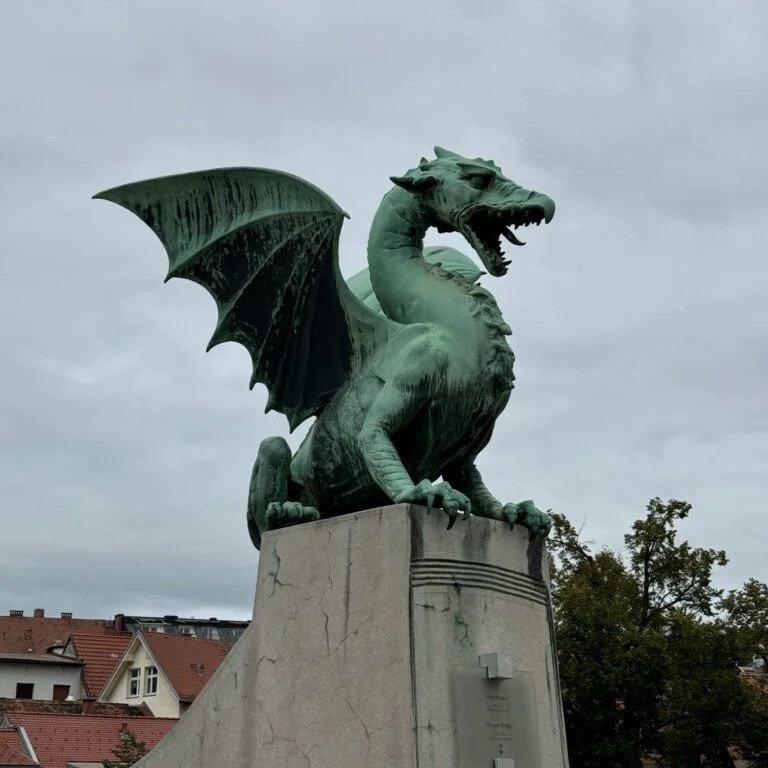

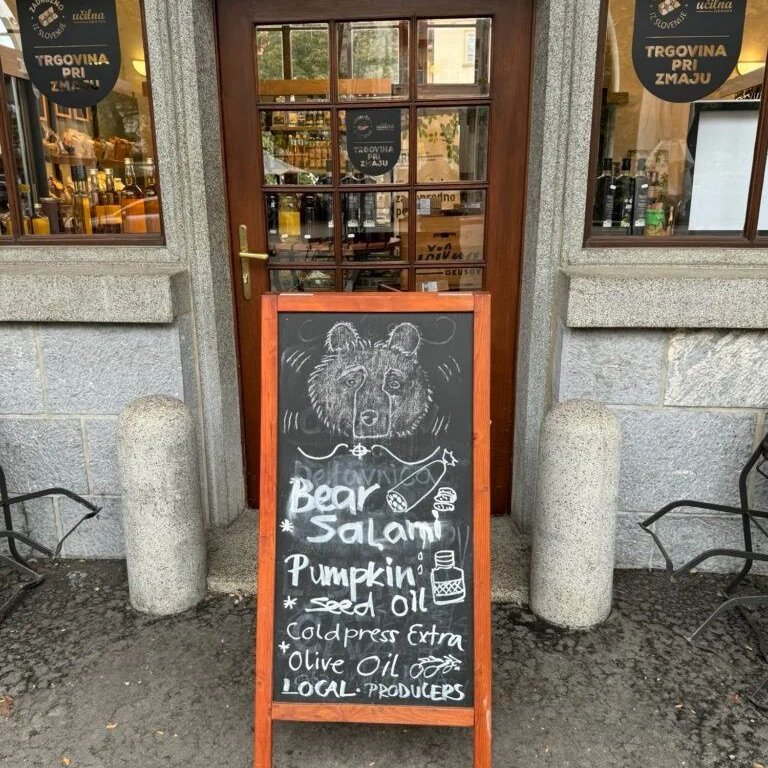
Our Ljubljana walking tour concluded at Congress Square, a historic gathering place surrounded by grand buildings and gardens. From there, we visited the Skyscraper terrace, a rooftop spot offering panoramic views of the city and Ljubljana Castle as the sun set. Sipping on a refreshing drink while watching the golden hues of the city was a perfect way to end our day.
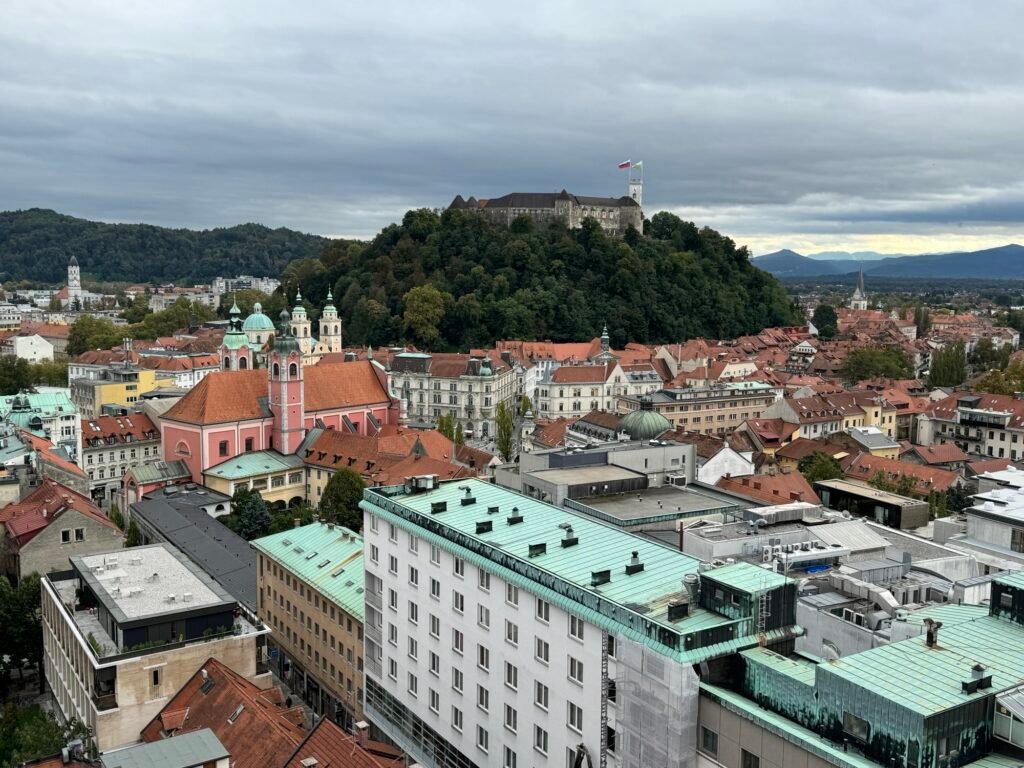
In the evening, we took a leisurely stroll along the Ljubljanica River. The street performances, colorful architecture, and the soft glow of city lights reflecting on the water created a magical atmosphere.

Where To Eat In Ljubljana
- Lunch: Bistro Čad – Located in Tivoli Park, this bistro serves hearty comfort food. The portions were generous—our sandwich and soup combo was more than enough for two.
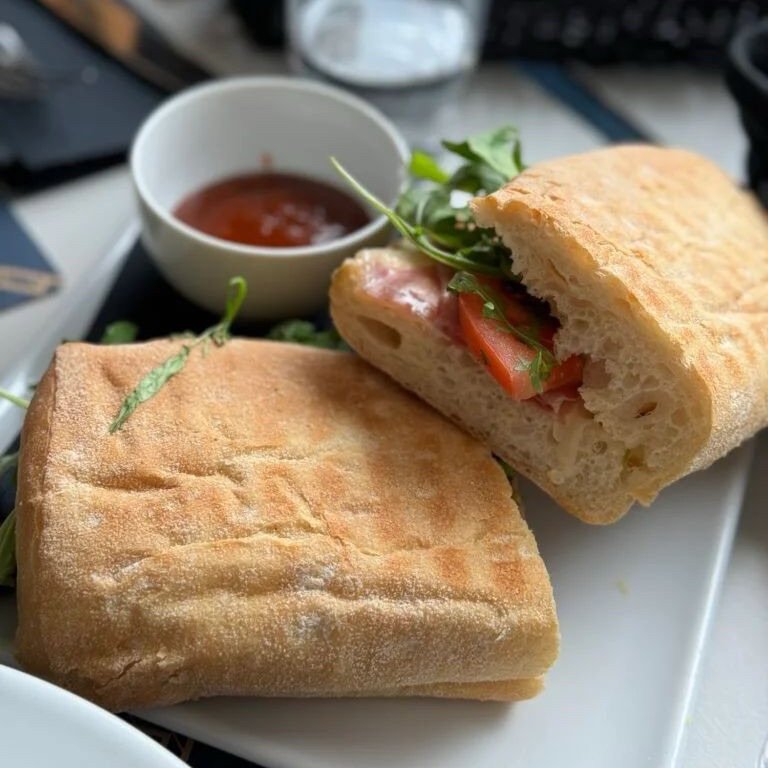
- Dinner: Slovenska Hiša – Figovec – A cozy spot offering traditional Slovenian dishes near the Skyscraper. The food was delicious and well-priced.
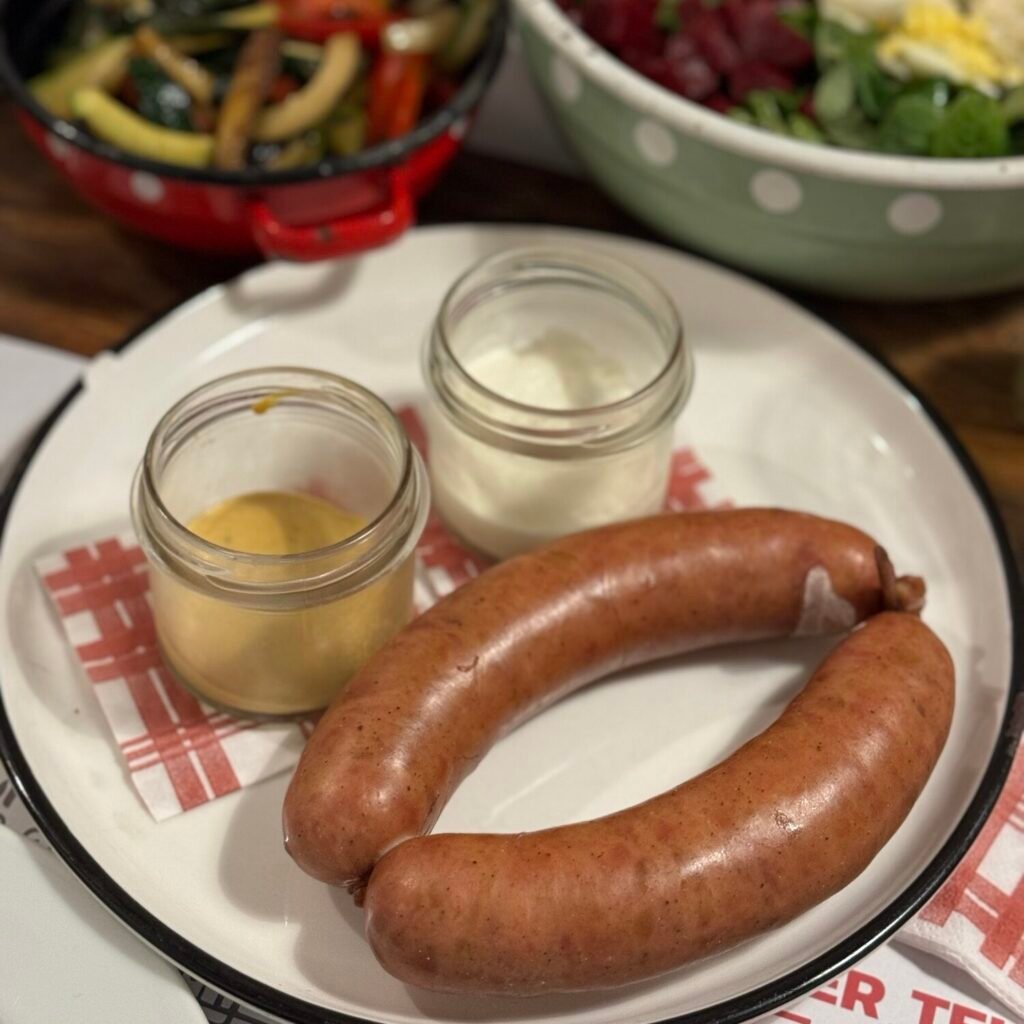
- Other recommended dining options in Ljubljana: Julija – modern Slovenian cuisine with friendly service, reservations highly recommended; and Gostilnica 5-6 kg – excellent Italian restaurant in a quiet residential area.
Where To Stay In Ljubljana
We stayed another night at the same cozy Airbnb as in Day 1, perfectly situated for exploring Ljubljana.
Travel Tips For Visiting Ljubljana
Plan your activities early to avoid afternoon crowds, especially in popular areas like Ljubljana Old Town. Don’t miss the central market for unique local treats and a taste of Slovenia’s culinary culture.
Day 3: The Magic of Lake Bled
Today, we picked up a rental car and headed to Lake Bled, a picturesque alpine lake renowned for its emerald-green waters, charming island with a church, and the iconic Bled Castle perched dramatically on a cliff. With serene views and a magical atmosphere, it was everything we’d dreamed of—a fairytale destination with breathtaking scenery.
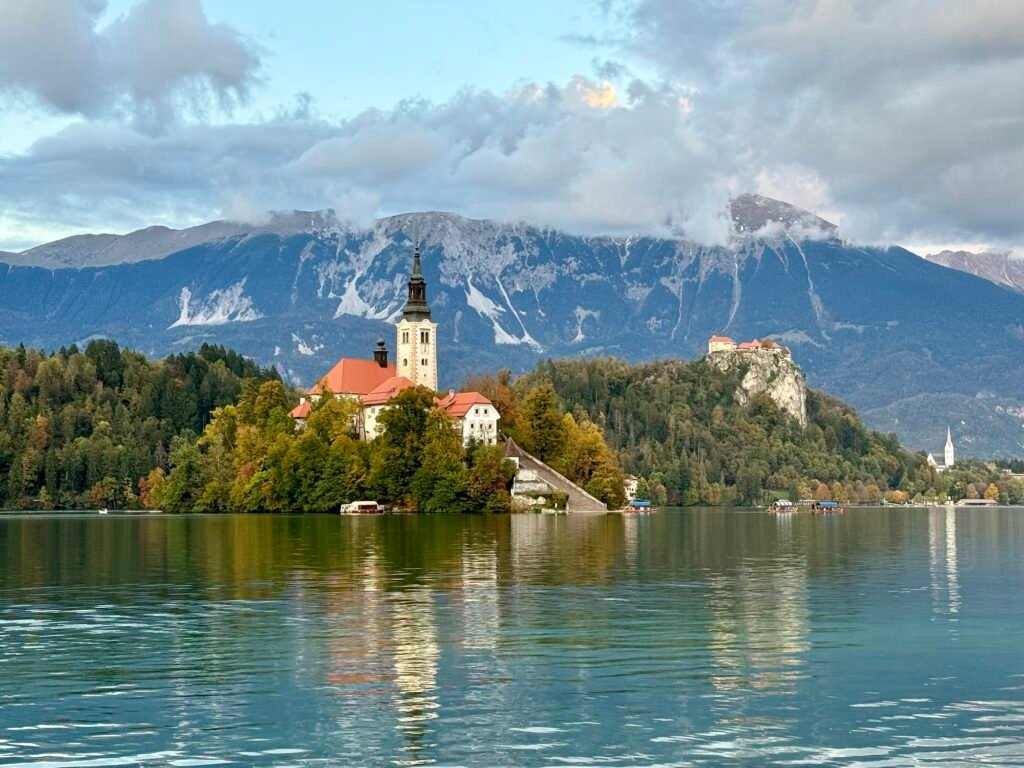
What To Do In Lake Bled
Our day began by picking up a rental car from Ljubljana’s city center in the morning. Once everything was in order, we set out on the hour-long drive to Lake Bled. The journey was a treat in itself, with rolling green hills, quaint villages, and distant views of the majestic Julian Alps.
Upon arriving at Lake Bled, we started with a leisurely stroll along the lake’s perimeter, taking in the tranquil surroundings. The emerald-green waters shimmered under the soft light, reflecting the surrounding peaks and forests. Graceful swans glided across the surface, adding an almost magical touch to the already enchanting landscape.
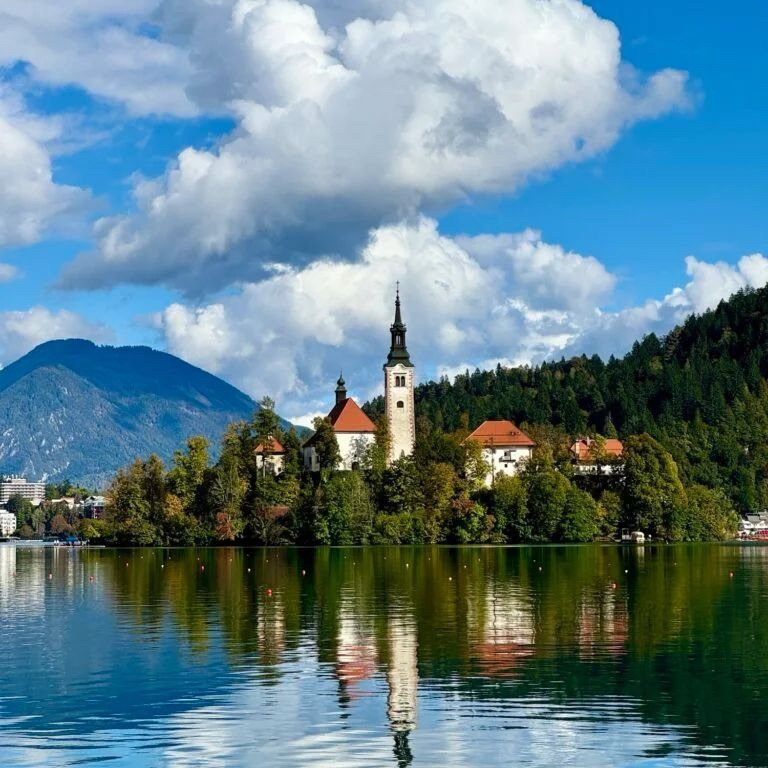


In the afternoon, we embarked on a serene boat ride to Bled Island aboard a traditional wooden pletna, expertly rowed by a local boatman. The gentle ride across the lake added to the charm of the experience. On the island, we climbed the picturesque stone steps to the Church of the Assumption and rang the wishing bell—a delightful tradition said to bring good luck and happiness.
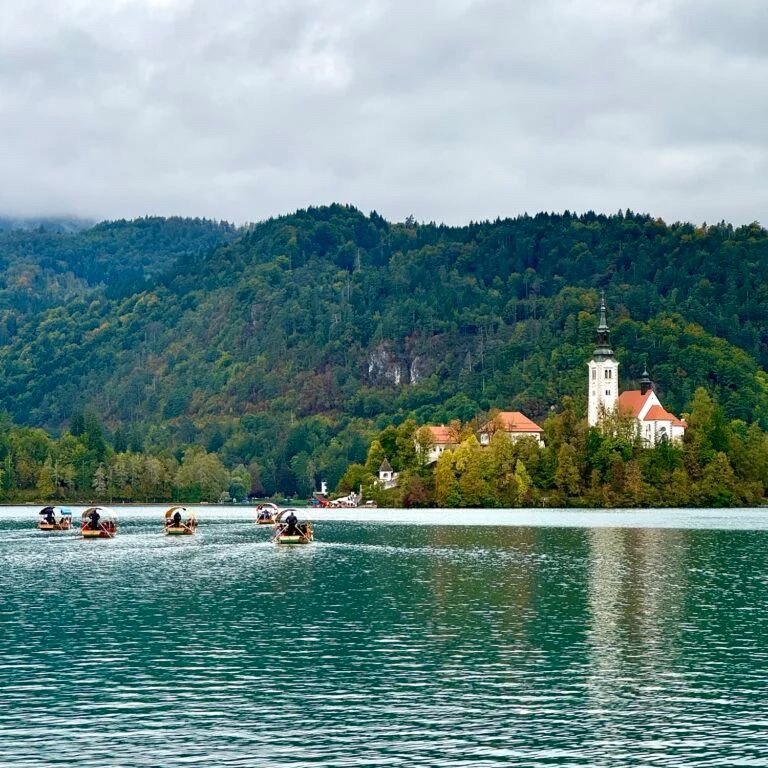

As rain clouds began to gather in the late afternoon, we decided to wrap up our exploration and check into our accommodation. On the way, we stopped to pick up fresh groceries and a slice of the legendary Bled cream cake. We ended the day enjoying a cozy home-cooked dinner and savoring the cake while reflecting on a fulfilling day.
Other Fun Things To Do in Lake Bled:
- Row Your Own Boat: Instead of hiring a boat rowed by a professional boatman, consider renting a traditional wooden rowboat and paddling to Bled Island at your own pace. This serene and active experience allows you to fully immerse yourself in the beauty of the lake. For couples, it’s an unforgettable romantic adventure!
- Go Paddleboarding: Paddleboarding offers a serene and intimate way to connect with the lake. The calm waters, especially in the early morning, are perfect for a peaceful adventure.
- Cycle Around Lake Bled: Explore the scenic trails circling Lake Bled by bike for an easy and enjoyable ride.
Where To Eat In Lake Bled
- Lunch: Oštarija Peglez’n, a cozy Italian restaurant in the heart of Bled, known for its fresh and flavorful dishes. We enjoyed the fish soup, seafood pasta, and grilled vegetables, all of which were delicious. Note: Many restaurants in Slovenia, including Peglez’n, charge a coverage fee per person. Additionally, their bottled water is quite pricey, so if you prefer, specify tap water, which is perfectly safe to drink in Slovenia.

- Dinner: We made a simple, homemade dinner with fresh groceries from a local supermarket. For those looking to eat out, consider Public & Vegan Kitchen Bled, known for its plant-based offerings, or Restavracija Central Bled, a centrally located spot offering diverse and well-reviewed menu options. Both provide inviting atmospheres and are conveniently situated near Lake Bled
- Dessert: Pastries from Planika Bakery, a charming local spot offering both sweet and savory treats. The Bled cream cake was a true standout—irresistibly creamy, perfectly balanced, and absolutely heavenly.
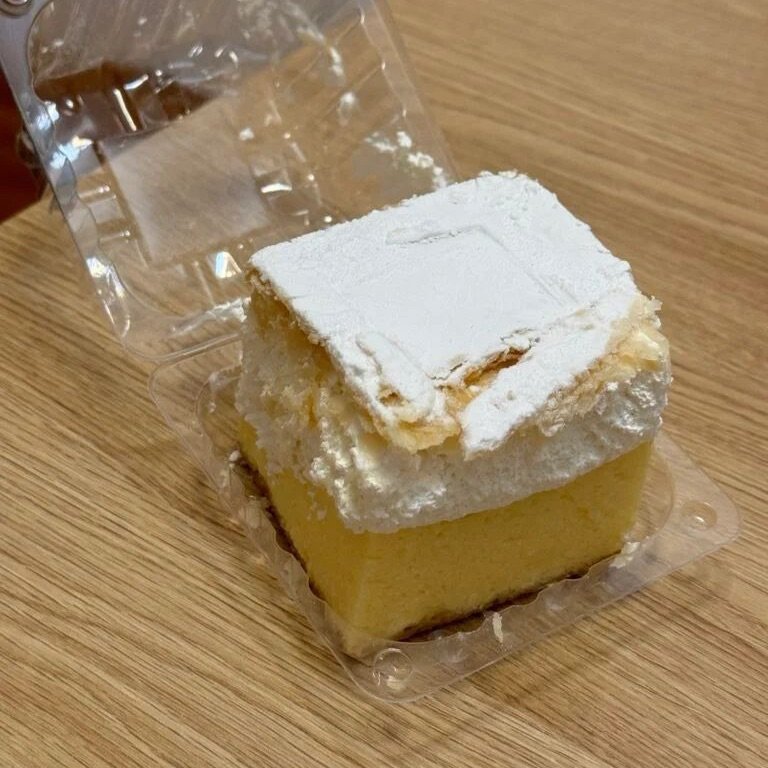
Where To Stay When Visiting Lake Bled
We stayed at a charming Airbnb in a mountain chalet in Zirovnica, a quaint alpine town just a short drive from Lake Bled. It offered a peaceful retreat with scenic mountain views, perfect for unwinding after a full day of exploration.

Travel Tips For Visiting Lake Bled
- Parking: Parking near Lake Bled can be challenging, particularly during peak hours. To secure a spot, aim to arrive early. Designated parking areas are conveniently located near the lake, but most require payment (and at a steep price). Be prepared with coins or a card to use parking meters.
- Comfort: Wear comfortable walking shoes to fully enjoy strolling around the lake and exploring the island, as there are uneven paths and steps along the way.
Day 4: Exploring Vintgar Gorge and Rediscovering Lake Bled
Today’s exploration took us to Vintgar Gorge, a stunning gateway to the Triglav National Park and one of Slovenia’s most iconic natural attractions. The morning’s adventure left us energized and eager to rediscover Lake Bled’s timeless charm by completing the hikes we had missed yesterday.
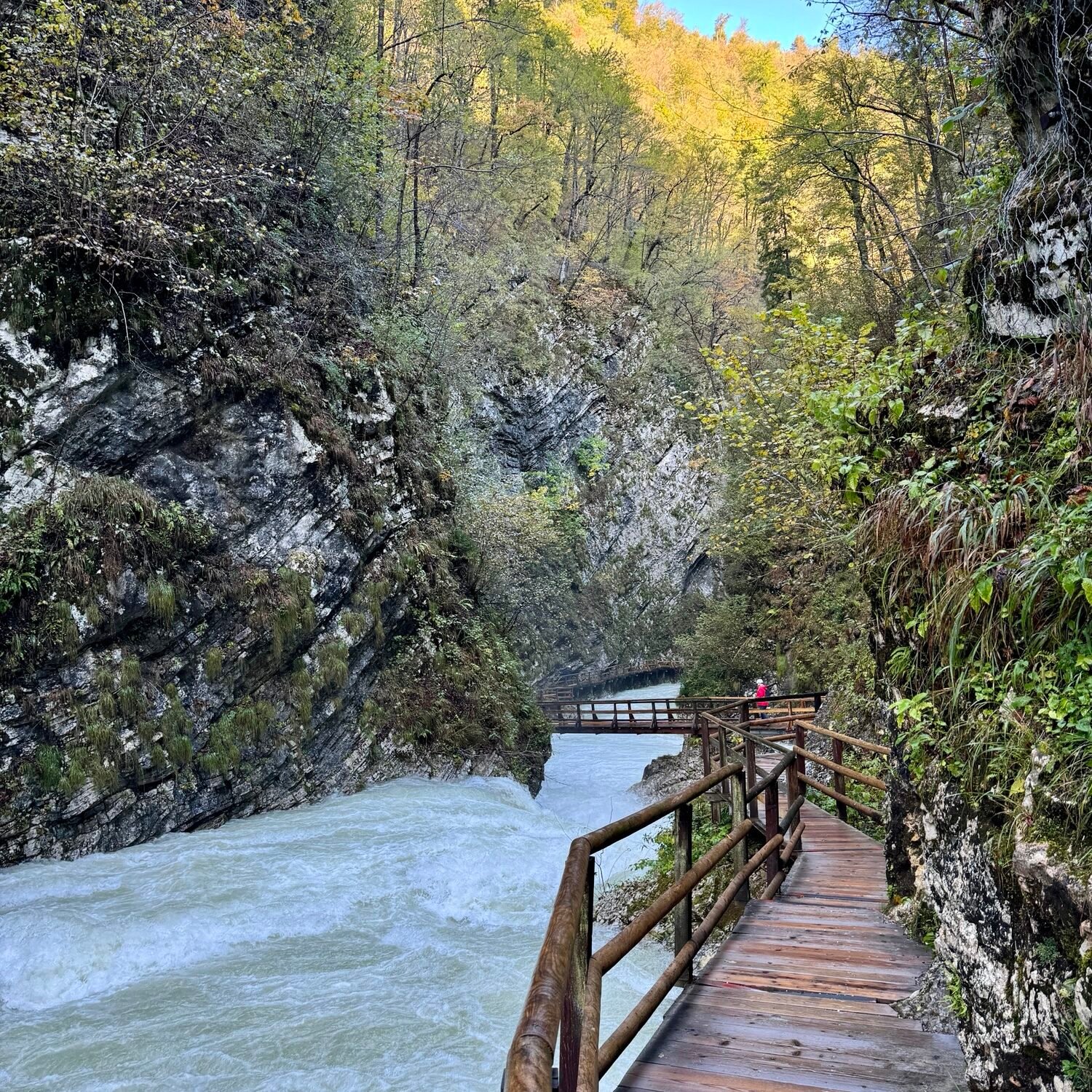
What To Do In Vintgar Gorge & Bled
We began our day at Vintgar Gorge, Slovenia’s largest and most captivating narrow gorge. To make the most of our experience, we pre-purchased timed entrance tickets online—a must since only 245 visitors are allowed inside at any given time. After parking at the central lot (€5 fee), we hopped on the free e-shuttle bus to the visitor center.
Equipped with helmets, we embarked on the 1.6 km wooden path that winds through the gorge. The journey was absolutely breathtaking. Recent rains had swelled the Radovna River, transforming it into a roaring torrent that echoed dramatically through the narrow chasm. Cool mist sprayed as we admired the river’s raw power crashing against towering cliffs—a humbling reminder of nature’s unyielding force. Coupled with the dramatic scenery, it left us in awe of the world’s natural beauty and our small place within it. The walk culminated at Šum Falls, a striking waterfall and fitting end to this unforgettable experience.
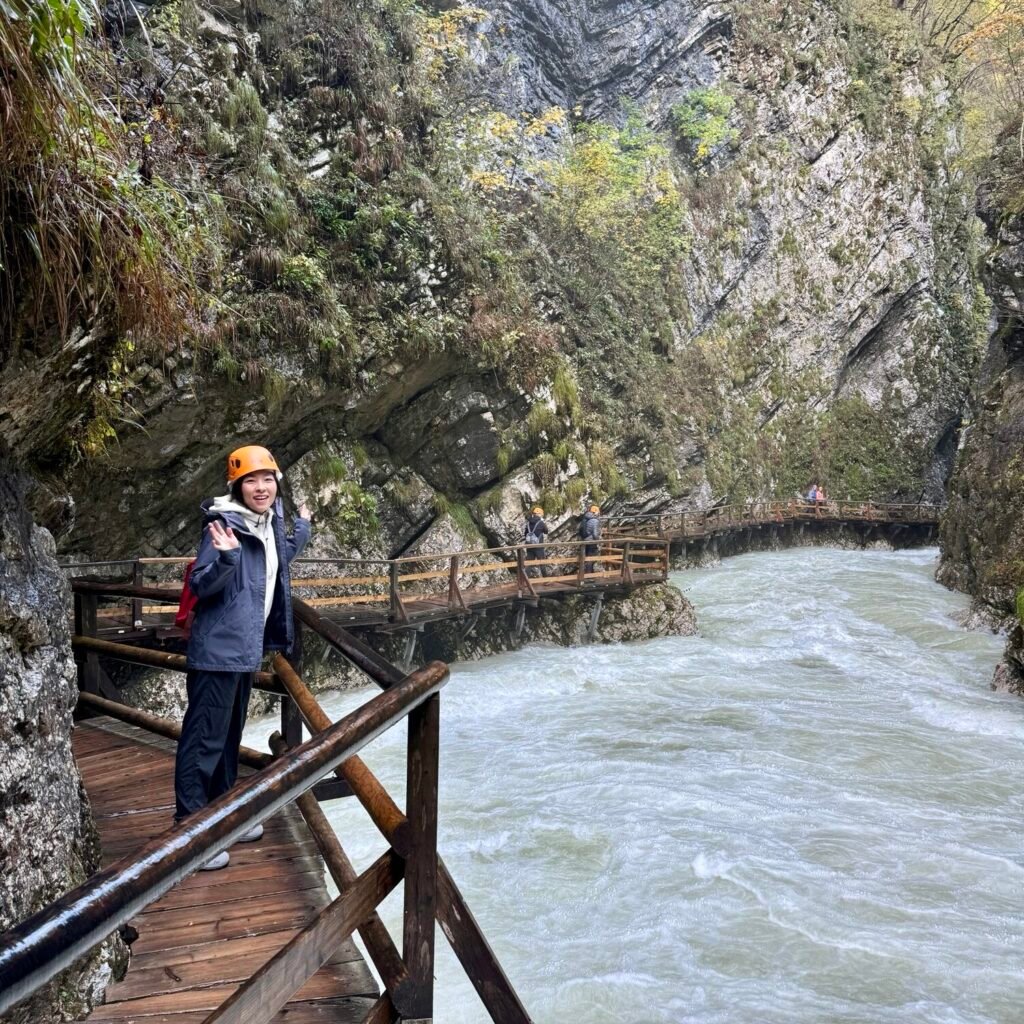
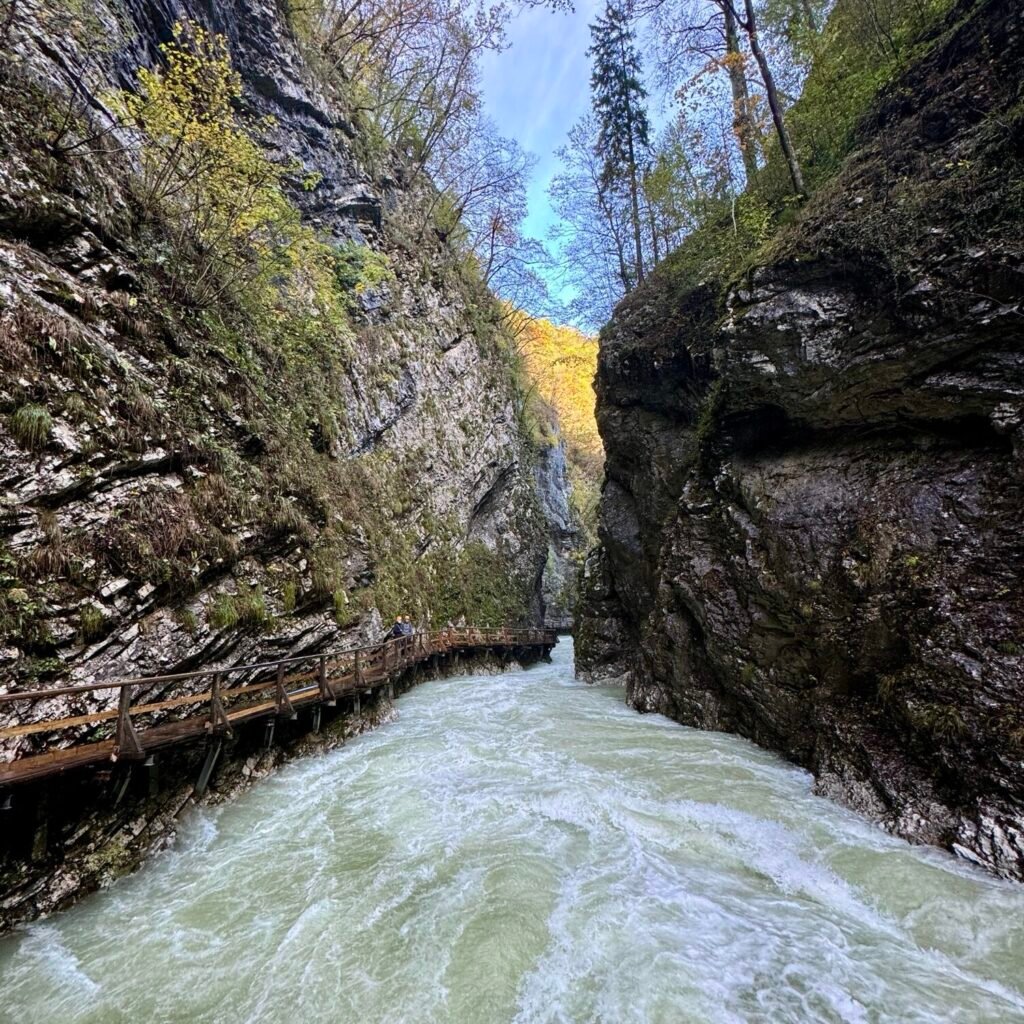


From Šum Falls, we continued on the River of Trees Trail, a peaceful 2.7 km loop through shaded forest paths. The gentle rustle of leaves and the soothing sound of flowing water accompanied us as the trail guided us back to the Vintgar Gorge visitor center.
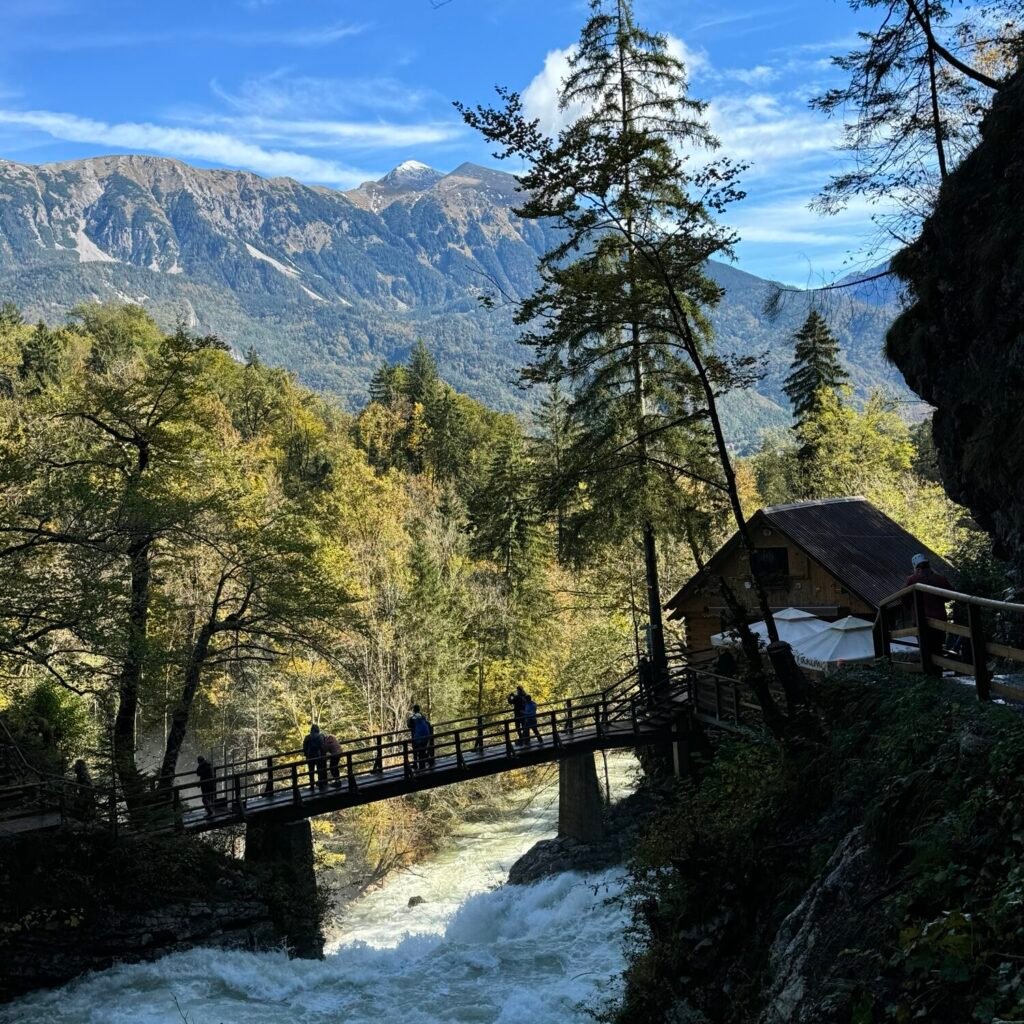

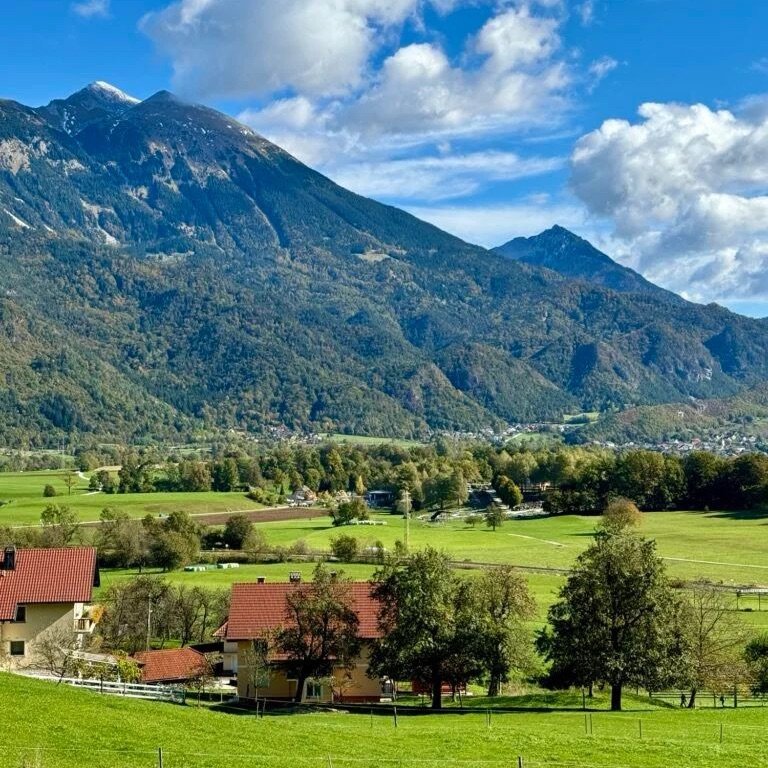
After a morning of exploration, we enjoyed a well-deserved lunch at a restaurant near Bled Castle. The food was delicious, complemented by stunning views of the surrounding peaks and valleys.

Compelled by the beauty of Lake Bled, we decided to revisit and tackle the Ojstrica and Mala Osojnica viewpoints—hikes that had been postponed yesterday due to weather and timing.
The climb to these viewpoints was steep and challenging, taking anywhere from 1 to 3 hours round-trip, depending on the route chosen and fitness level. The effort it took to reach the summit only heightened our sense of reward as we took in the breathtaking panoramic view of Lake Bled — the turquoise waters glimmering below, the island with its charming church standing serenely at the center, and vivid cloud formations framed by majestic mountains. Standing there, we felt a deep sense of accomplishment and wonder, marveling at the landscape we had long envisioned. This spontaneous decision turned out to be a highlight of our day.
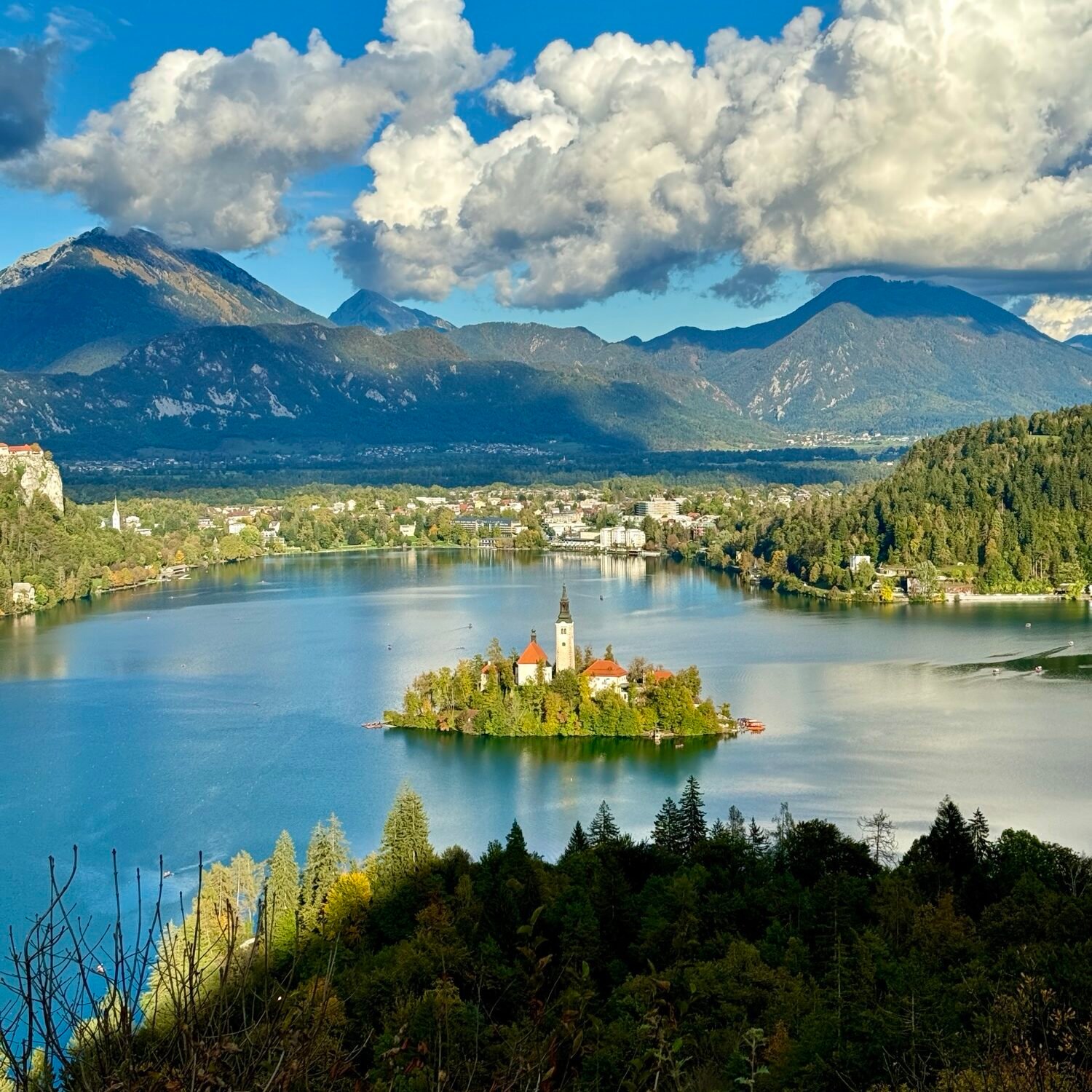
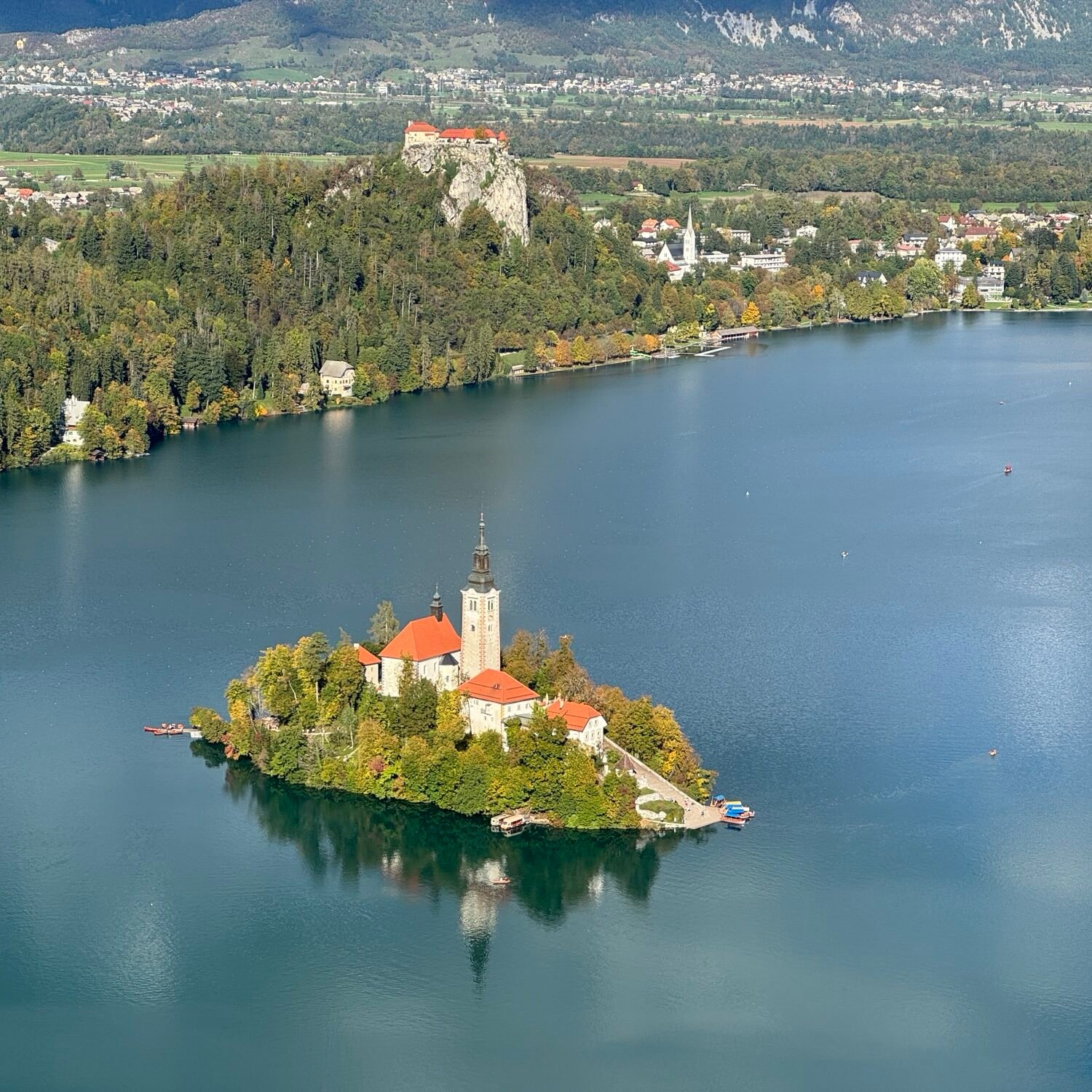
After descending from the viewpoints and taking some time to relax, we ended the day with another beautiful stroll along the Lake Bled shore, watching stunning sunset hues and cloud formations reflecting on the lake.

Other Fun Things To Do Near Lake Bled:
- Explore Peričnik Waterfall: A beautiful and secluded waterfall for nature lovers where you can walk behind the cascading water—a unique and magical experience.
- Tour Bled Castle: For history enthusiasts, Bled Castle offers a fascinating museum and a terrace with unparalleled views of the lake.
- Try Paragliding Over Lake Bled: For adventure seekers, paragliding provides a thrilling bird’s-eye view of Lake Bled and its surrounding landscapes. Soaring above the turquoise waters and lush greenery is an unforgettable experience.
Where We Ate In Lake Bled
- Lunch: Gostilna In Pizzeria Grajska Preža – A cozy restaurant near Bled Castle with stunning views of the surrounding mountain peaks and valleys. The pizza was perfectly cooked, the roasted vegetables had a juicy charcoal flavor, and the grilled meat was excellent.

- Dinner: We returned to our Airbnb and enjoyed another cozy homemade meal. If you prefer dining out, consider visiting one of Bled’s highly rated establishments: Pizzeria Rustika for hearty, wood-fired pizzas, Old Cellar Bled for authentic Slovenian cuisine in a rustic setting, or ARROI Restaurant for flavorful Asian-inspired dishes. Each offers a unique dining experience to suit different tastes.
Where To Stay When Visiting Bled
The same cozy Airbnb in Zirovnica, continuing to offer a perfect base for exploring the surrounding areas.
Travel Tips For Visiting Vintgar Gorge And Lake Bled
- Vintgar Gorge: Visit early morning or late afternoon to avoid crowds. Purchase timed entrance tickets online in advance to secure your spot. Parking at the central lot costs €5, and a free e-shuttle bus runs every 20 minutes to the visitor center.
- Hiking Equipment: Wear sturdy outdoor footwear and bring plenty of water for the steep and uneven trails to the Ojstrica and Mala Osojnica viewpoints. Hiking poles can be very helpful if you have them. Much of the trails are exposed, so apply sunscreen, wear a hat, or bring sunglasses on sunny days, and carry a rain jacket if the weather looks uncertain.
- Plan Ahead: Allocate sufficient time for both Vintgar Gorge and Lake Bled activities, as each offers unique experiences that deserve unhurried exploration.
Day 5: Serenity at Lake Bohinj
Our journey continued to Lake Bohinj, a tranquil gem nestled within the Julian Alps. Unlike the bustling charm of Lake Bled, Bohinj offered a quieter, more natural retreat that felt like a step closer to Slovenia’s untouched beauty.
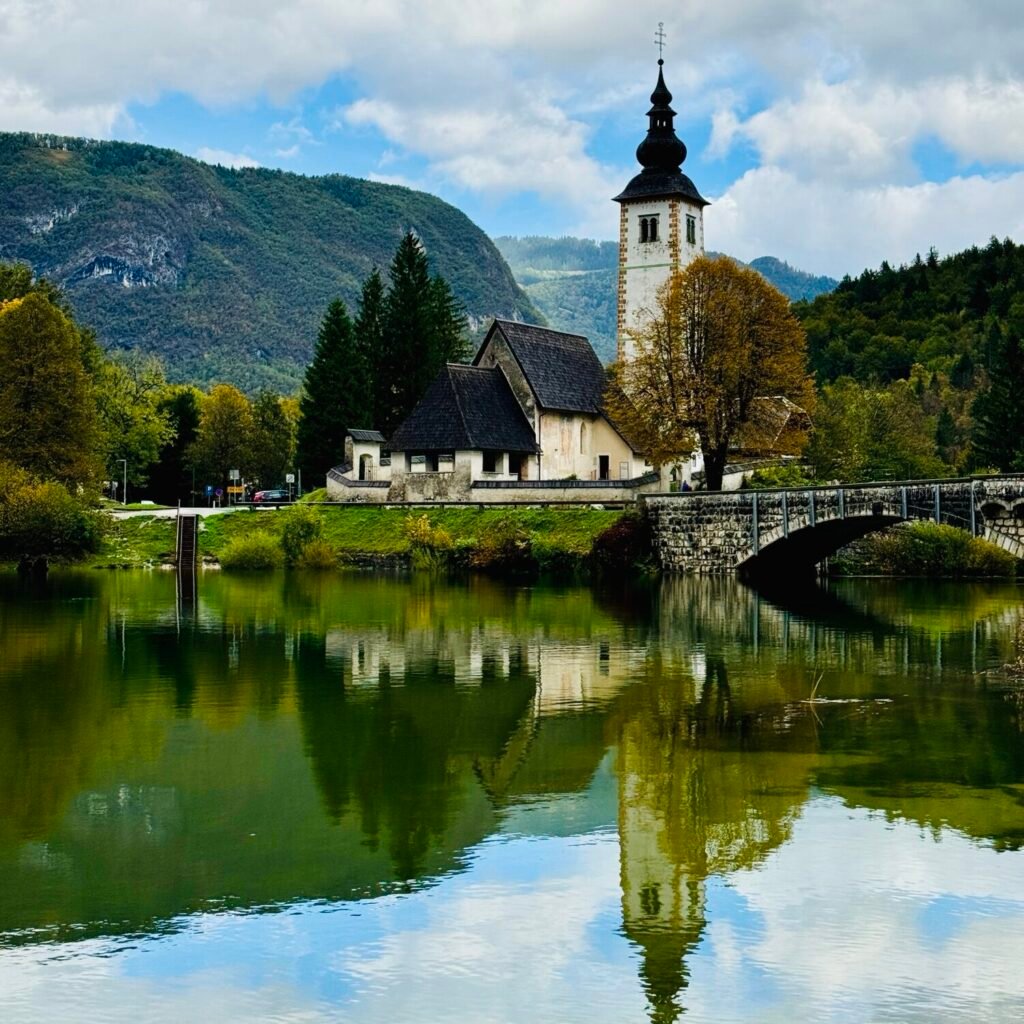
What To Do In Lake Bohinj
We started our day with a scenic drive from our Airbnb in Zirovnica to Lake Bohinj (approximately one hour away). The road meandered through lush forests and picturesque villages, setting a tranquil tone for the day ahead.
Once we arrived, we immediately noticed the serene atmosphere that sets Bohinj apart from Lake Bled. With far fewer tourists, it felt like a hidden gem. We began by walking the trail along the lake’s pristine shoreline, where the crystal-clear waters mirrored the surrounding alpine peaks. The peacefulness of the setting was truly captivating.

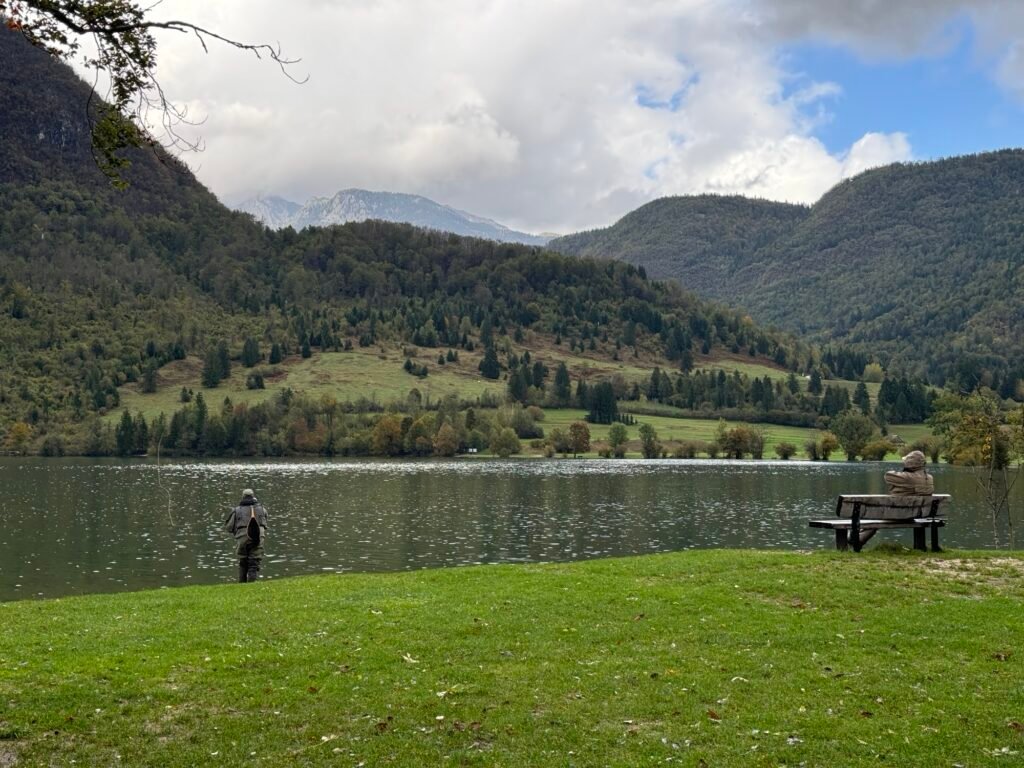
Next, we visited the charming Church of St. John the Baptist, a 13th-century gem near the lake’s eastern edge. The church’s well-preserved frescoes and its picturesque setting beside the lake made it a highlight of our visit. The stone bridge nearby added to the idyllic charm, making it a perfect photo spot.
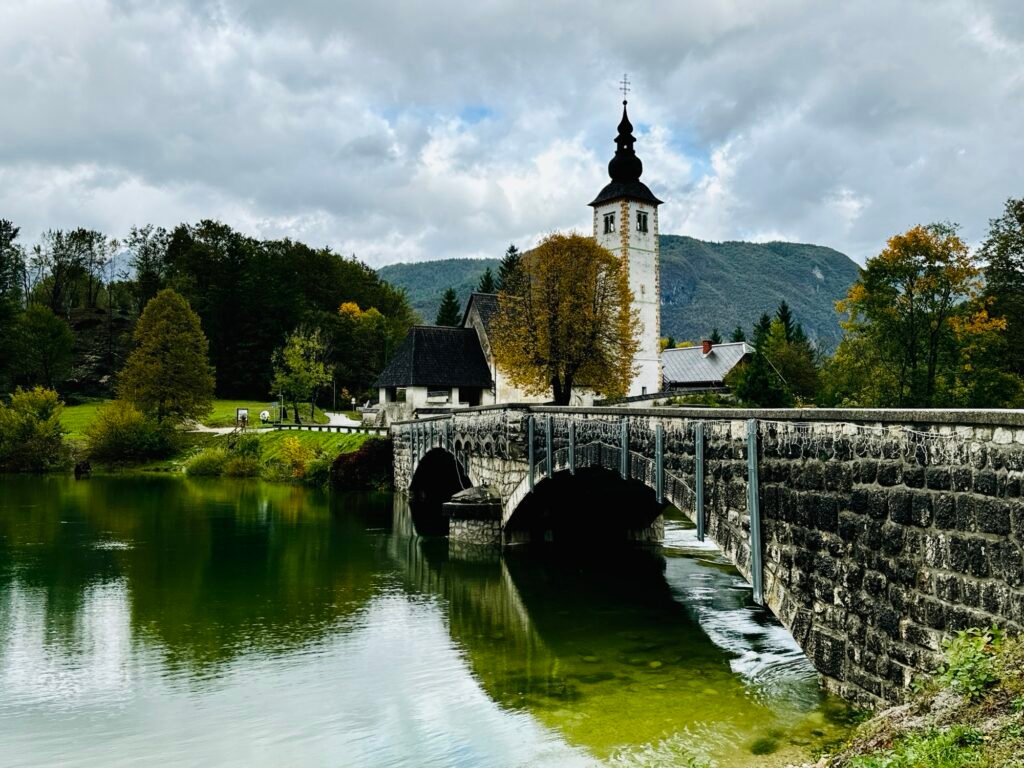
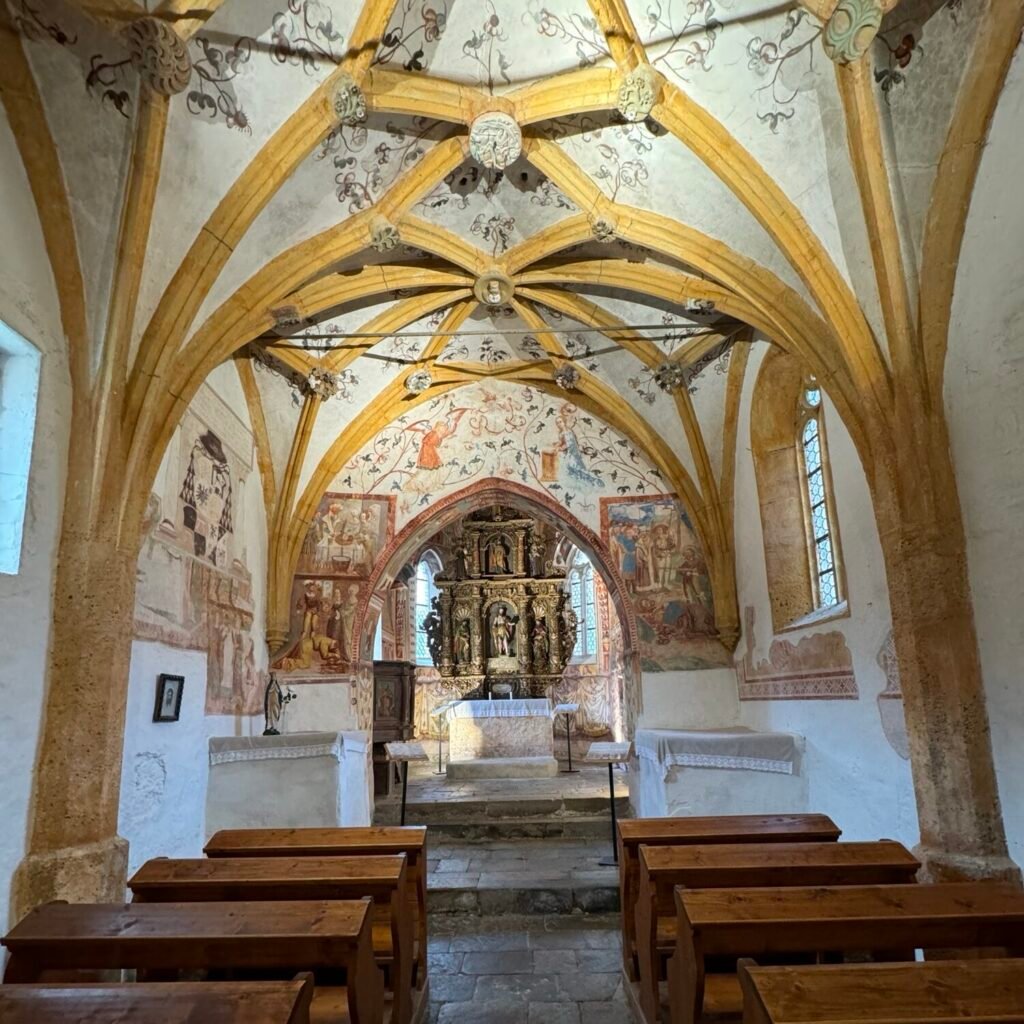
For a touch of adventure, we hiked to Savica Waterfall, a stunning two-tiered waterfall tucked within the forest. The trail was short but has steady incline, winding through the greenery before revealing the powerful cascade of water plunging into a pristine pool below. The sight was both awe-inspiring and calming, a natural spectacle that felt like a reward for our efforts.



For the rest of the afternoon, we continued to explore the area by driving around the lake, stopping at various viewpoints to appreciate the tranquil beauty of Bohinj. The calm surroundings and the lack of crowds made it an ideal spot for quiet reflection and connection with nature.
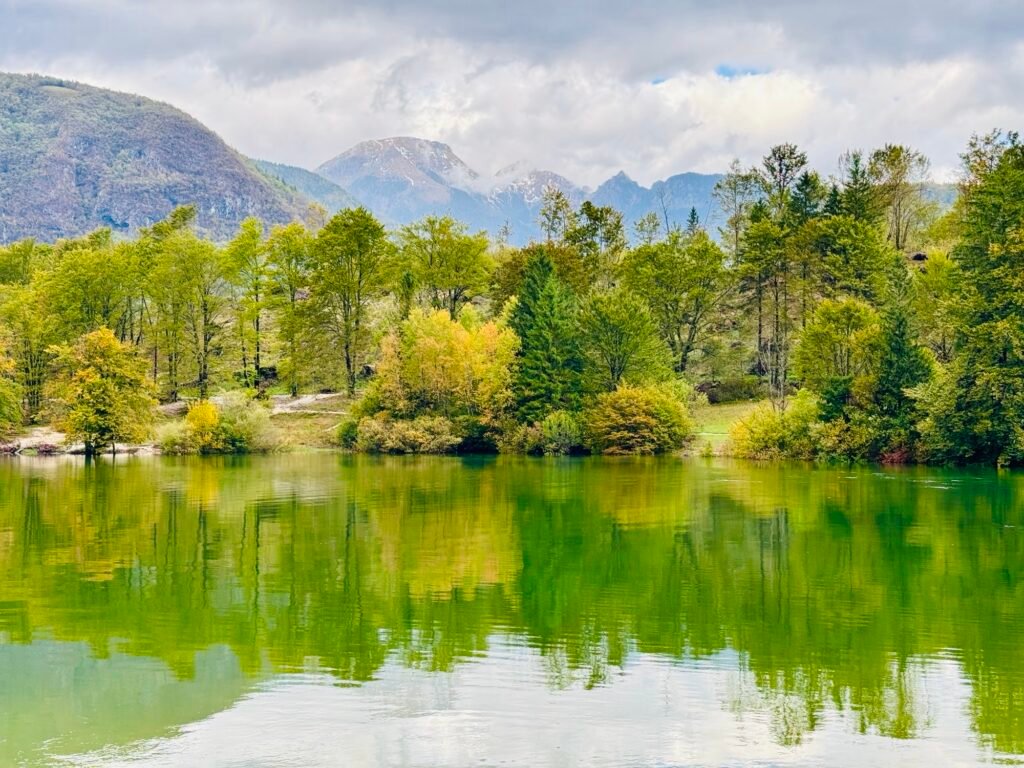
Other Fun Things To Do Near Lake Bohinj: If you have extra time or want to experience more adventures during your visit to Lake Bohinj, consider these activities:
- Ride the Vogel Cable Car: Take a scenic ride to the Vogel Ski Center for breathtaking panoramic views of Lake Bohinj and the Julian Alps. At the summit, enjoy short walks, relax with a coffee, or set out on more challenging hikes. Pro Tip: Check live webcams on the Vogel Ski Center’s website to assess weather and visibility before planning your visit.
- Explore Mostnica Gorge: Just a short drive from Bohinj, this peaceful trail winds along crystal-clear waters and dramatic rock formations. It’s less crowded than other gorges and takes about 1.5–2 hours round-trip, offering a serene escape into nature.
Where To Eat In Lake Bohinj
- Lunch: We dined at the Center Restaurant, the only option open during our visit. While the food was decent, it wasn’t particularly memorable. It served its purpose as a convenient stop before continuing our exploration.
- Dinner: Returned to our Airbnb for a homemade dinner.

Where To Stay When Visiting Bohinj
The same charming Airbnb in Zirovnica, offering a peaceful retreat after a day of outdoor adventures.
Travel Tips For Visiting Bohinj
- Parking: Parking at Lake Bohinj and Savica Waterfall is available and affordable but can fill up quickly during peak times. Arrive early for easier access.
- Snacks and Water: Pack snacks and water, as dining options near Lake Bohinj may be limited depending on the time of year. Plus, enjoying snacks by the lake is another simple but satisfying way to soak in the views while staying immersed in nature.
- Comfort: Wear sturdy and comfortable walking shoes as the trail to Savica Waterfall but could be slippery, especially after rain.
- Rain Gear: The weather at Lake Bohinj can be unpredictable, so pack a lightweight rain jacket or umbrella to stay prepared for sudden changes.
Day 6: Journey to Škocjan Caves and Smarje
Our journey today began with the awe-inspiring Škocjan Caves, a natural masterpiece and UNESCO World Heritage Site that left us utterly spellbound. Later, we transitioned from the marvels of underground exploration to the serene charm of Smarje, a Mediterranean gem nestled in Slovenia’s Karst region. This day offered a perfect blend of subterranean wonder and rural tranquility.
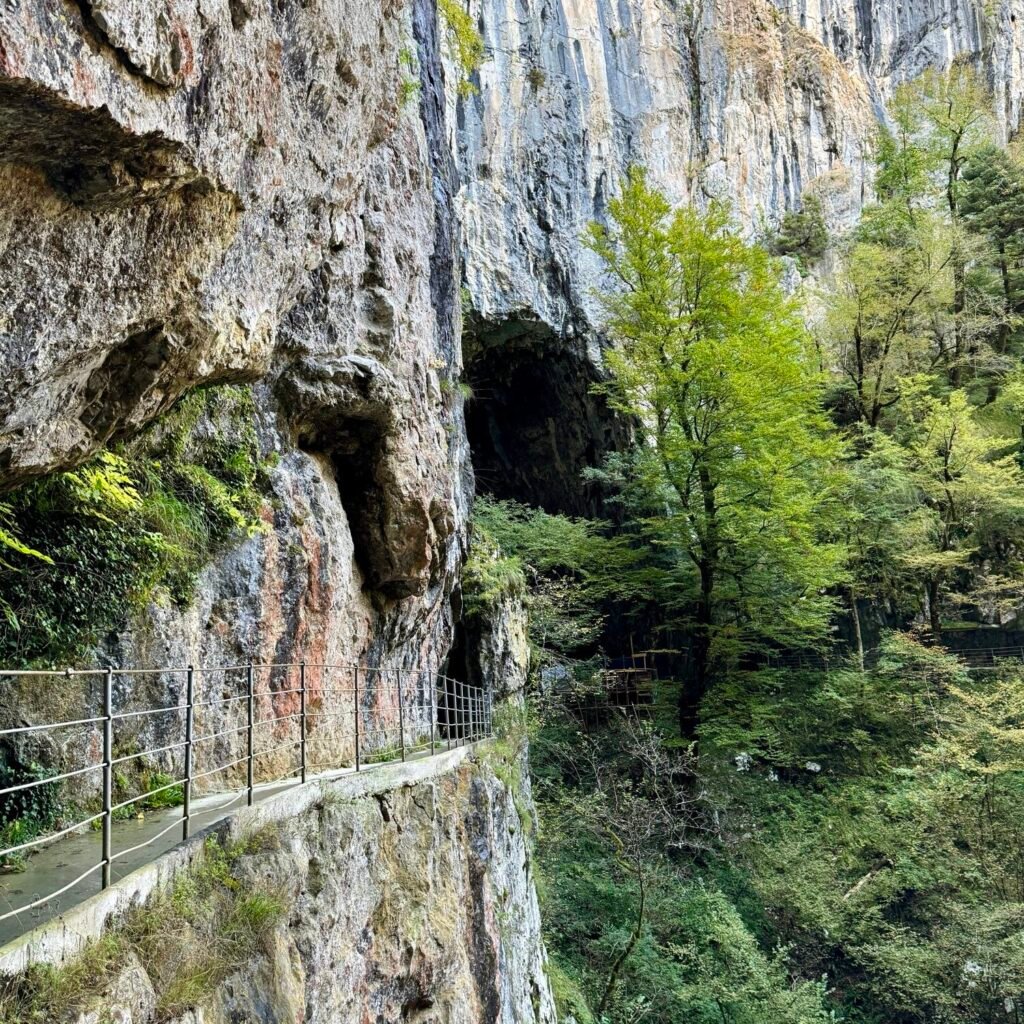
What To Do When Visiting Skocjan Caves And Smarje
We began our day with a scenic drive from Zirovnica to Divača, a small town near the Škocjan Caves. The journey took approximately an hour, offering picturesque views of Slovenia’s countryside. Upon reaching Divača, we stopped for a hearty lunch, giving us the energy needed for the exciting exploration ahead.
With our appetites satisfied, we made our way to the Škocjan Caves, a true marvel of nature and by far the most impressive cave we’ve ever explored. Slovenia’s karst terrain is home to over 8,000 caves, and Škocjan stands out as its largest and longest. A guided tour is required to explore the caves, which we had booked in advance through the official website (on-site booking is also available).
Stepping into the Škocjan Caves felt like entering an otherworldly realm. Vast chambers unfolded before us, with a roaring underground river carving through the heart of the canyon. The formations—stalactites and stalagmites shaped over millennia—were utterly captivating. This hidden realm of wonder left us feeling small, yet profoundly connected to the raw power and artistry of nature.
Photography is prohibited inside Škocjan Cave to preserve the delicate environment, but the experience itself was unforgettable. The tour covered the main chambers, but we also took time to hike the surrounding Škocjan Education Trail, which offered stunning views of the karst landscape above ground. Reflecting on our visit, it was remarkable how this subterranean world felt both humbling and otherworldly.



In the late afternoon, we continued our drive to Smarje (approximately 50 minutes away), enjoying views of rolling hills, vineyards, and olive groves along the way. Smarje is a quiet town that embodies the Mediterranean charm of Slovenia’s Karst region. We checked into our accommodation and unwind after an adventurous day.

Where To Eat Near Skocjan Caves And Smarje
- Lunch: Gostilna in Mesnica Malovec – Located in Divača, this charming restaurant offered hearty Slovenian dishes. The grilled mushroom was a standout, and the welcoming atmosphere made it a delightful stop.

- Dinner: Lars & Sven Burger – A local burger chain at a shopping mall on the way to Smarje. The decor resembled Shake Shack in the US, but the menu had its own local flair, making it a satisfying quick meal.

Where To Stay In Smarje
We stayed at Santomas Apartments, a cozy Airbnb located in Smarje, right next to the town’s only church. From 7 AM to 8 PM, the bells chimed every 15 minutes, a delightful rhythm that gently nudged us into a daybreak-to-dusk lifestyle. For a natural night owl like me, this shift to early mornings was surprisingly refreshing, and the serene pace of life in Smarje made it easy to embrace.

Travel Tips For Visiting Skocjan Caves and Smarje
- Škocjan Caves: Book your guided tour in advance to secure your preferred time. Allow at least three hours to explore both the caves and the surrounding trails. Wear sturdy shoes, as the cave paths can be uneven, and bring a light jacket since the caves remain cool year-round.
- Dining near Škocjan Caves: Divača is a convenient stop for lunch, offering several good local restaurants near the caves. There is also an on-site restaurant at the cave’s visitor center.
- Driving: The drive from Škocjan Caves to Smarje offers scenic views of Slovenia’s rolling hills and vineyards. Be prepared for narrow, winding roads common in the Karst region, and take your time to enjoy the journey.
Day 7: Exploring Piran and Relaxing by the Adriatic
Our journey continued with a leisurely day in Piran, a picturesque coastal town on Slovenia’s Adriatic coast. Known for its well-preserved medieval architecture, narrow streets, and stunning views, Piran offered the perfect mix of exploration and relaxation.

What To Do In Piran
We started the day with a scenic drive from Smarje to Piran (about 30 minutes away), passing rolling hills and catching glimpses of the shimmering Adriatic Sea. Our first stop was Tartini Square, the vibrant heart of Piran. The square’s elegant Venetian architecture and lively atmosphere set the tone for the day. From there, we ascended to St. George’s Parish Church, perched on a hill. The church offered stunning views of Piran and the Adriatic Sea, providing a serene contrast to the bustling square below.

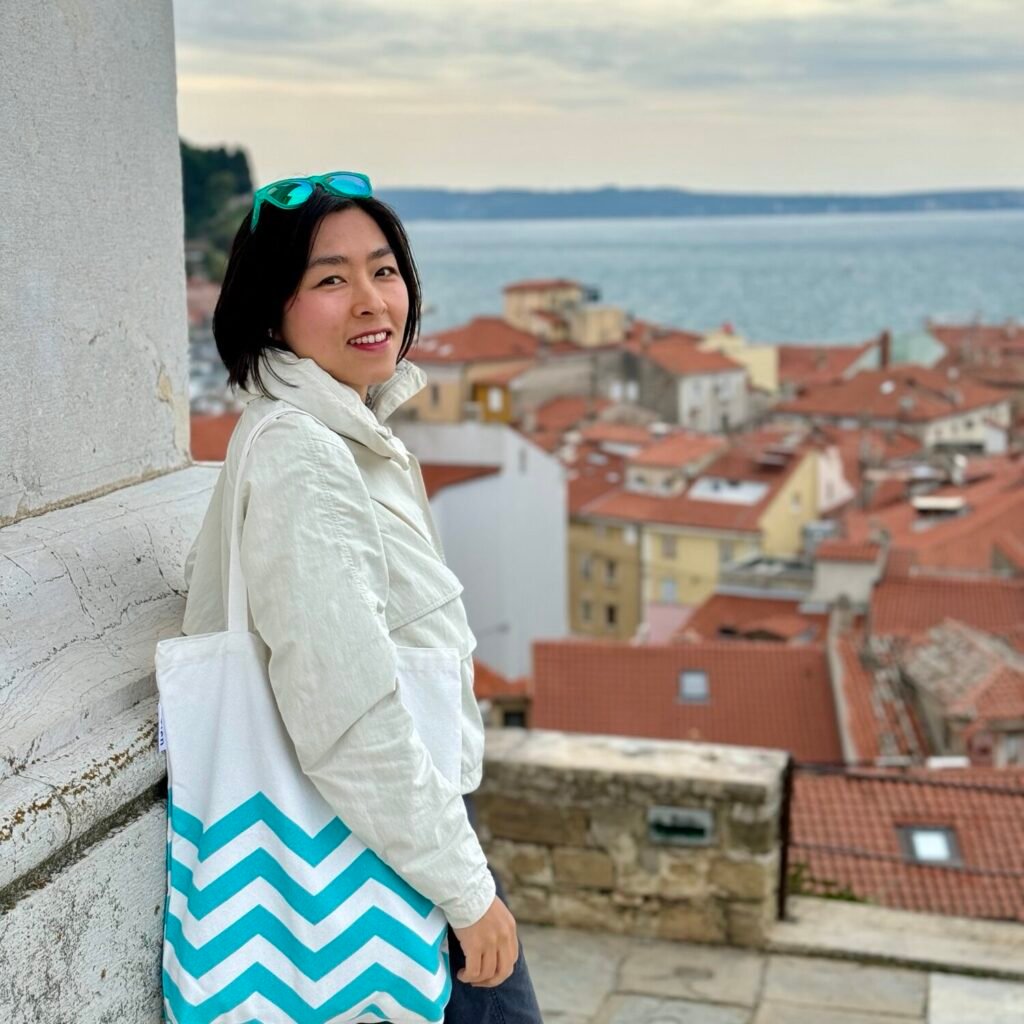
We then climbed the Bell Tower, which rewarded us with sweeping panoramic views of the red-roofed Old Town, the Adriatic Sea, and even glimpses of Croatia and Italy on clear days. The effort of the climb was well worth it, as the vistas were absolutely breathtaking. After descending, we took a well-deserved lunch break, enjoying a relaxed meal in a charming corner of the Old Town.



After lunch, we wandered through the labyrinth of medieval streets in the Piran Old Town, soaking in the town’s rich history and coastal charm. Every narrow alley seemed to lead to a hidden gem, whether it was a quaint shop, a peaceful courtyard, or a surprising view of the sea. One particularly memorable discovery was a local farmer’s stand in the town center, brimming with vibrant produce and friendly smiles. It reminded me of how we used to shop before supermarkets became the norm—fostering a sense of community and connection to local traditions. Inspired, we made a spontaneous decision to buy fresh ingredients for dinner.

Drawn by the promise of stunning views, we headed to the Ancient Piran City Walls. The experience was a true highlight of our visit. The elevated vantage point provided another stunning perspective of Piran’s Old Town, with its iconic red roofs and the sparkling Adriatic in the background. This serene moment made us truly appreciate the town’s unique beauty.
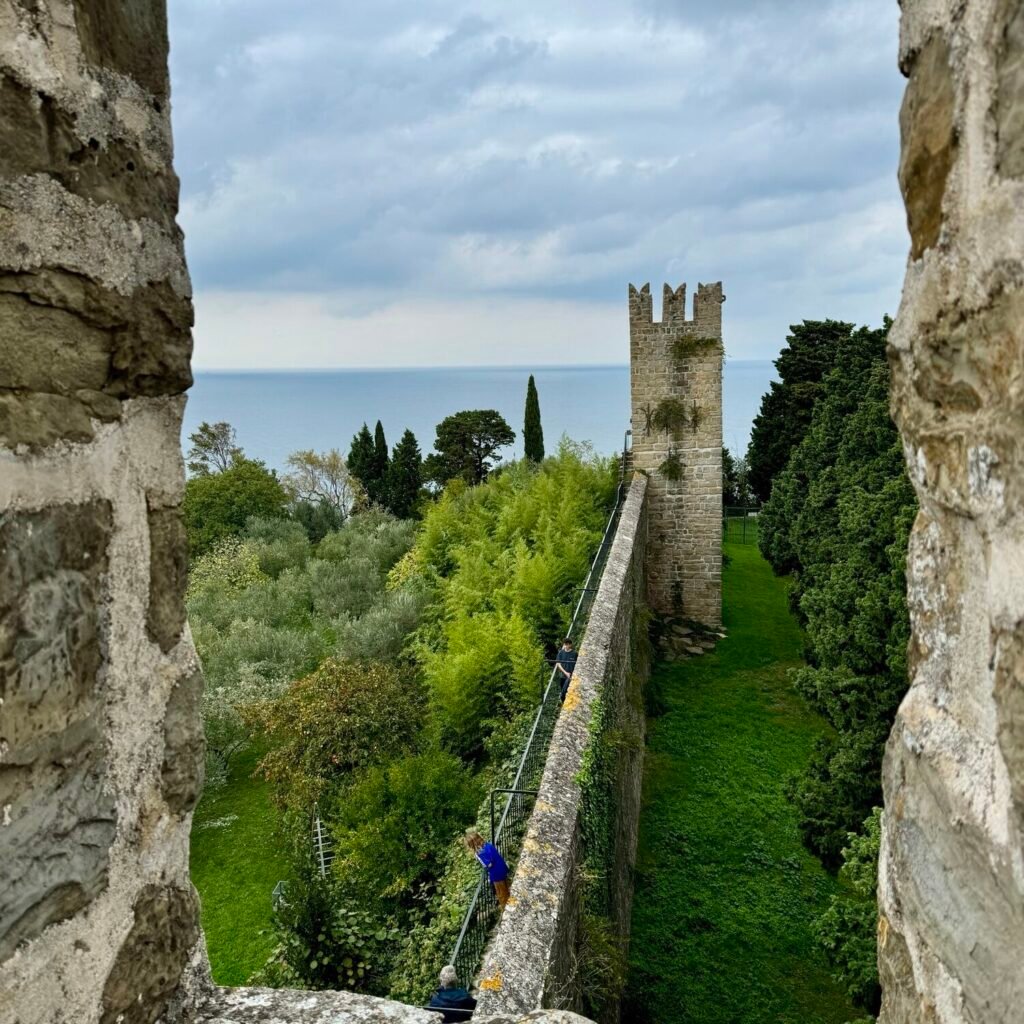
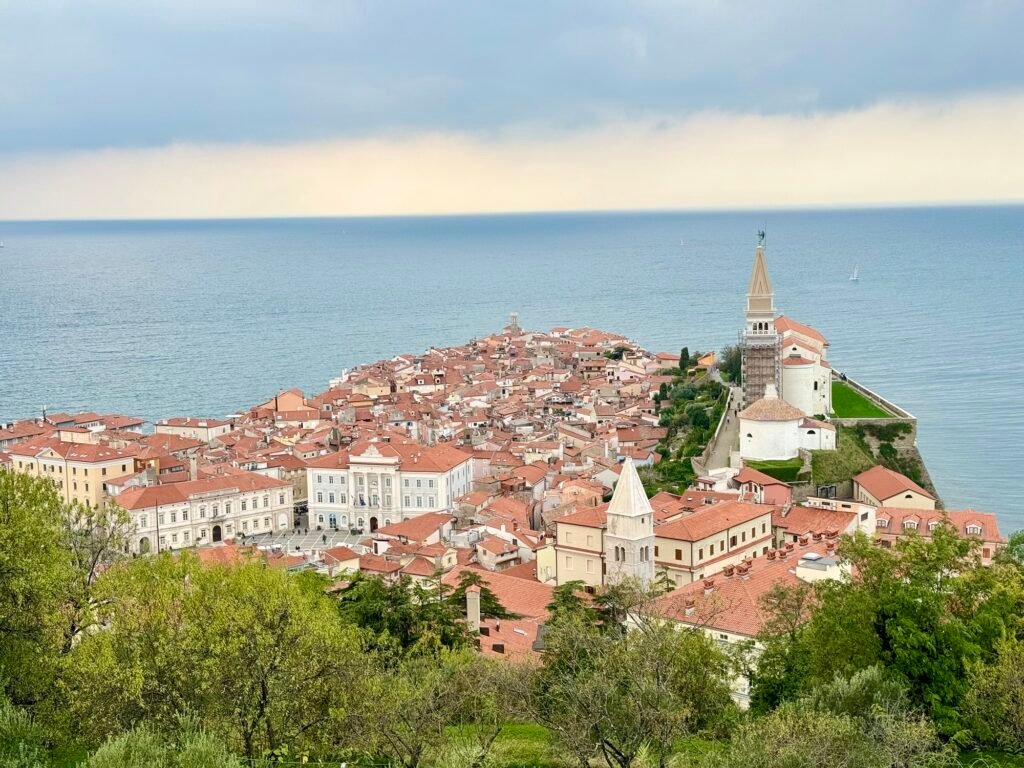
To unwind, we strolled along the Piran Seafront Promenade, enjoying the fresh sea breeze and the rhythmic sound of waves. The relaxed pace of life in Piran was contagious, making it easy to savor every moment.

Other Fun Things To Do Near Piran:
- Piranski Svetilnik (Piran Lighthouse): Visit the iconic lighthouse at the tip of the peninsula for a peaceful spot to admire the sea and take photos.
- Strunjan Nature Reserve: A short drive from Piran, this protected area features scenic walking trails, salt pans, and serene coastline views.
- Local Wineries: Explore nearby wineries to sample Slovenian wine, particularly the region’s renowned Malvasia and Refosco varieties.
Where To Eat In Piran
- Lunch: Fritolin Pri Cantini – This fantastic seafood restaurant tucked away in a small plaza in Piran’s Old Town was a highlight of the day. The menu offered a variety of delicious seafood dishes at reasonable prices, paired with a laid-back atmosphere.
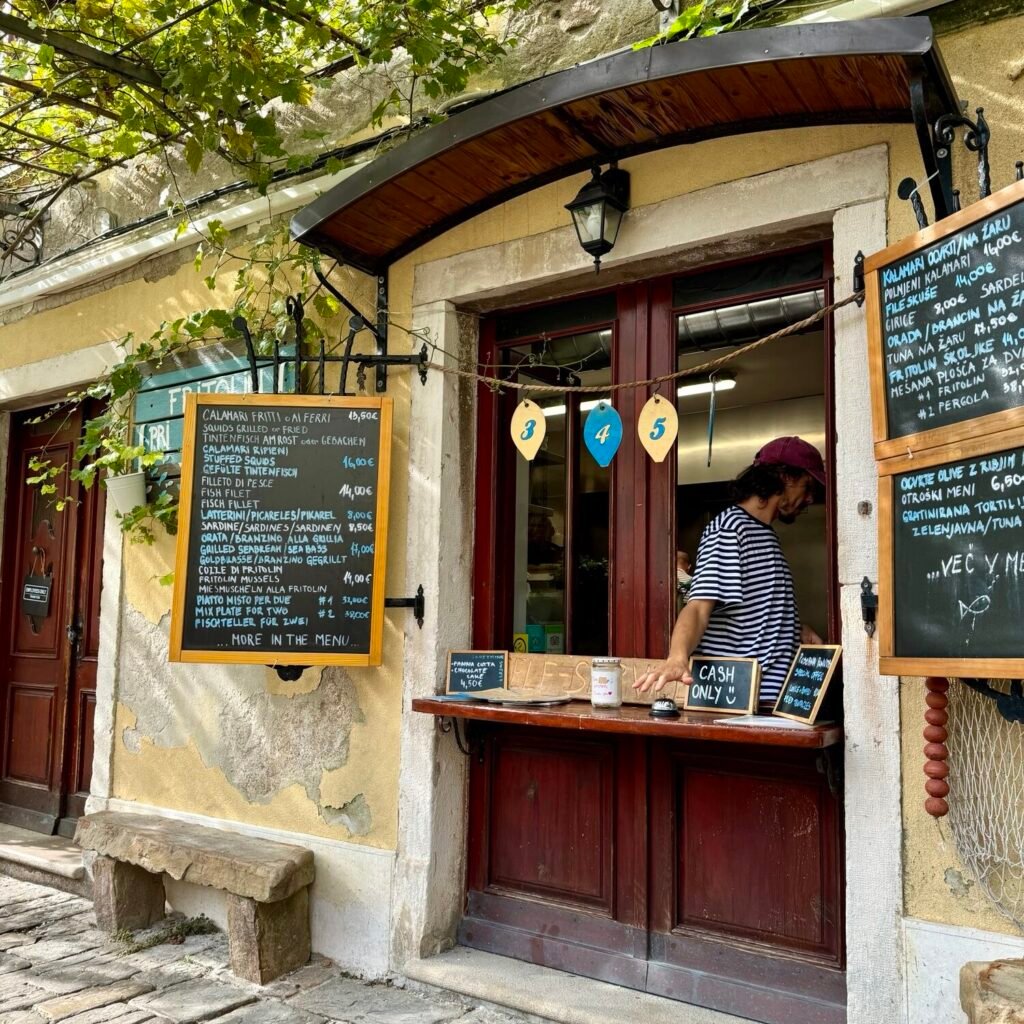
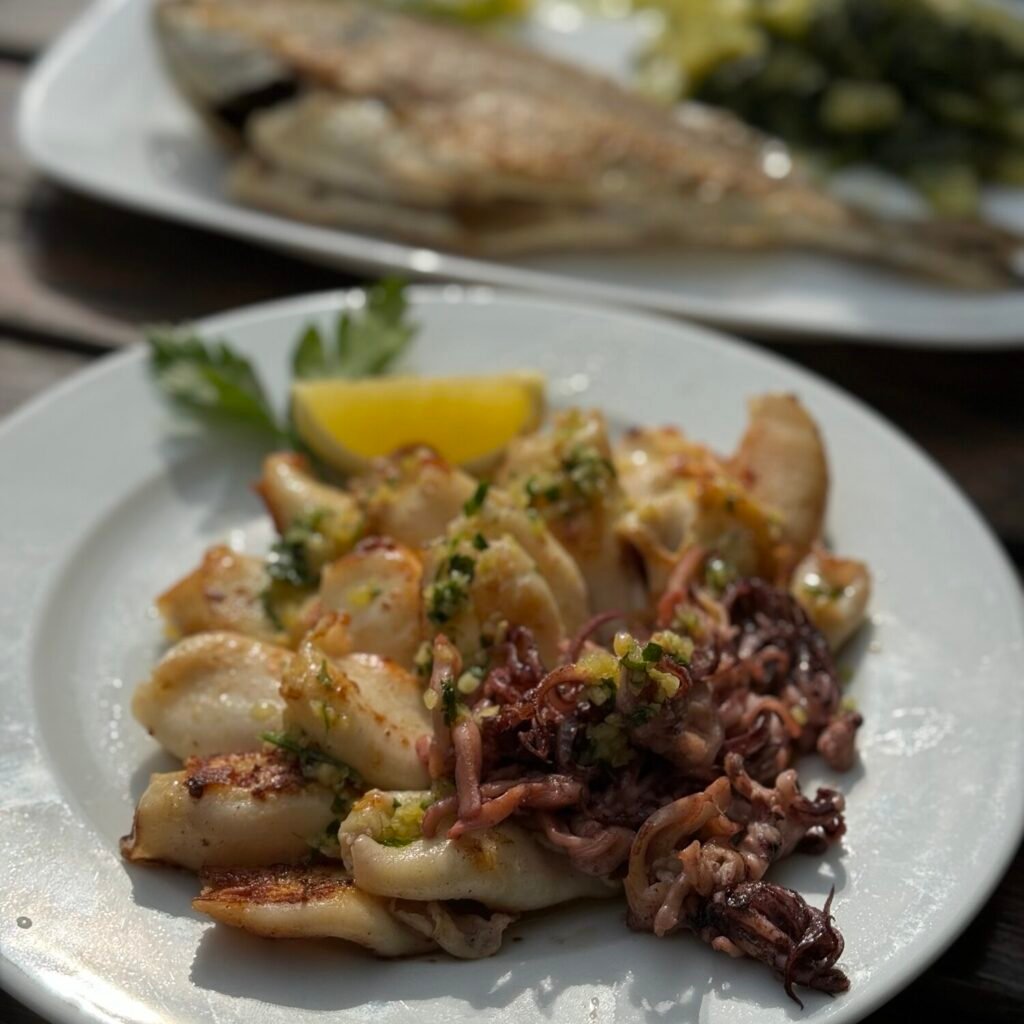
- Dinner: A homemade meal at our Airbnb in Smarje, made using fresh ingredients picked up from the farmer’s stand we discovered in Piran. Preparing the meal brought back fond memories of simpler times and added a personal touch to the day’s culinary experience.
Where To Stay When Visiting Piran
The same cozy Airbnb in Smarje as in Day 6, just a short scenic drive away from Piran.
Travel Tips For Visiting Piran
- Driving: The drive from Smarje to Piran is straightforward, but keep an eye on GPS directions, especially near border areas. During our drive, we nearly crossed into Croatia by mistake due to a GPS misdirection. It was a small adventure that added a touch of excitement to the journey and a reminder to double-check routes in border regions.
- Comfortable Shoes: Piran’s streets are cobblestoned and uneven, so wearing comfortable shoes is essential for exploring.
- Parking Tips: Parking in Piran is limited, as the town is mostly pedestrianized. The Fornačę car park outside the town center is a convenient option, with a free shuttle running regularly to the main square. Some visitors also park at Parkirišče Grand Hotela Bernardin, a spot technically reserved for hotel guests but often used by others without issue. Be aware, though, that parking here is at your own risk, as the hotel may issue tickets.
Day 8: Exploring Predjama Castle and Farewell to Slovenia
Our final day in Slovenia was a bittersweet blend of awe and nostalgia. We visited the incredible Predjama Castle, a true medieval marvel, and bid farewell to Slovenia as we transitioned to the next leg of our journey.
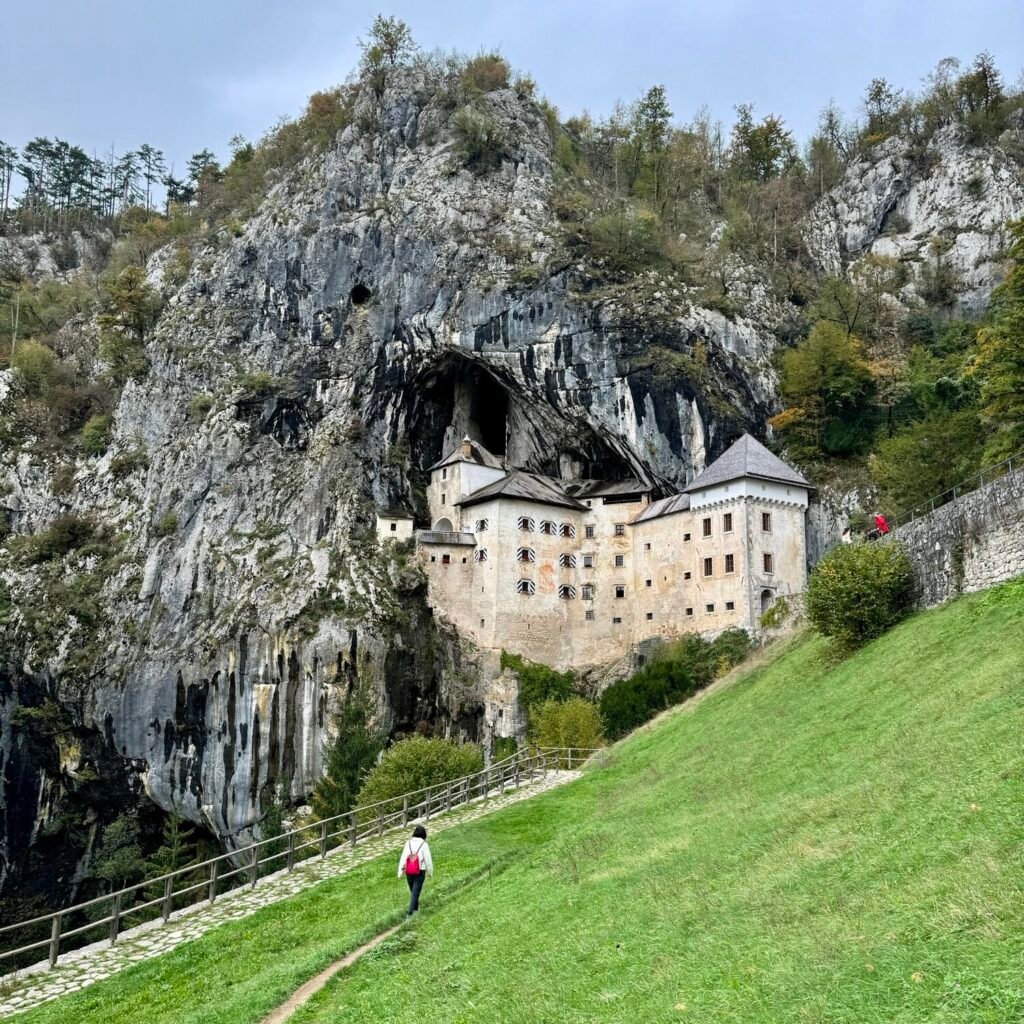
What To Do When Visiting Predjama Castle
We started the day with a drive to Predjama Castle, a medieval marvel nestled dramatically within a cave (approximately a one-hour drive). Recognized as the largest cave castle in the world, Predjama is a masterpiece of ingenuity and history. Built in the 12th century and expanded over four centuries, the castle seamlessly blends natural cave walls with human craftsmanship, creating an awe-inspiring fortress. Walking through its halls, we marveled at the ingenuity required to construct such a fortress on a 123-meter cliff face. The integration of natural rock and man-made stonework made it difficult to distinguish where nature ended and human innovation began—a true testament to its design. Imagining its role as both a defensive stronghold and a sanctuary during times of conflict added depth to our visit. This remarkable blend of function and beauty left an indelible mark on us, encapsulating Slovenia’s rich history and innovative spirit.
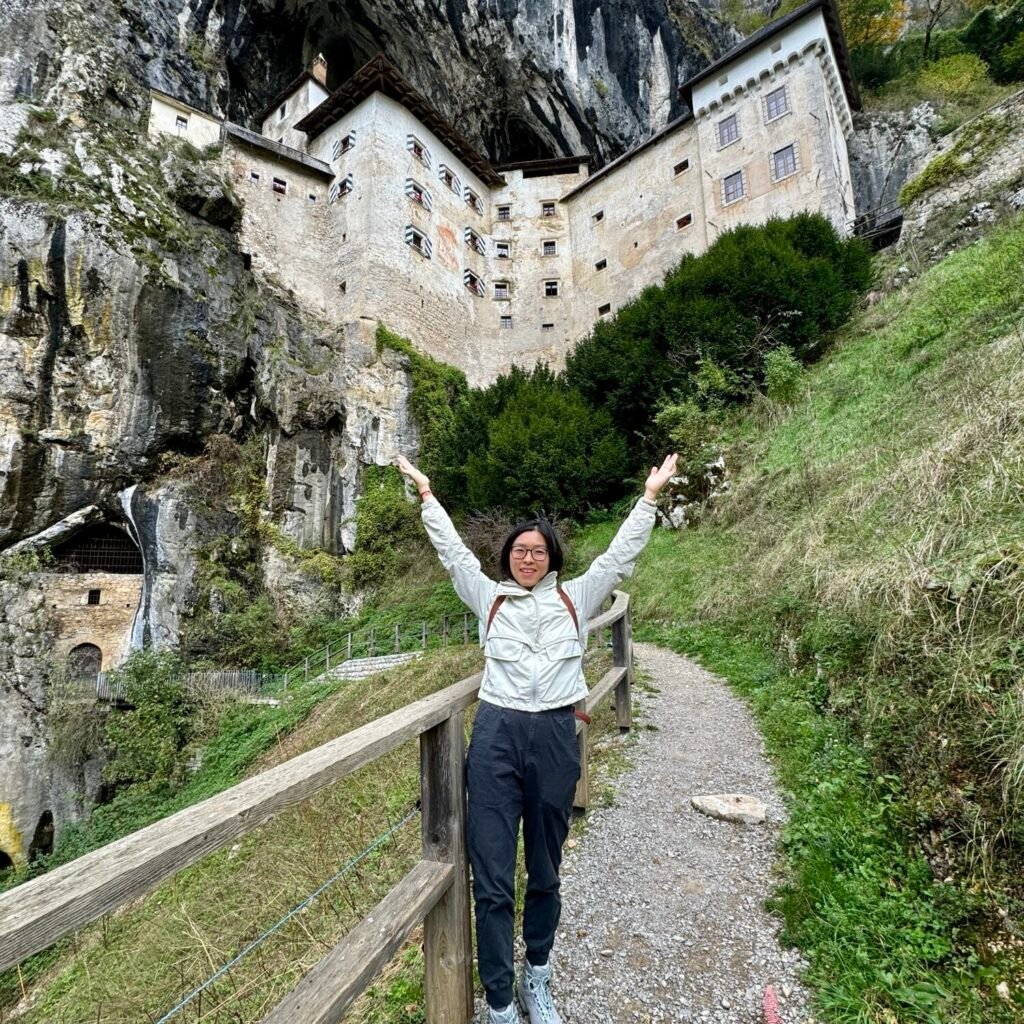

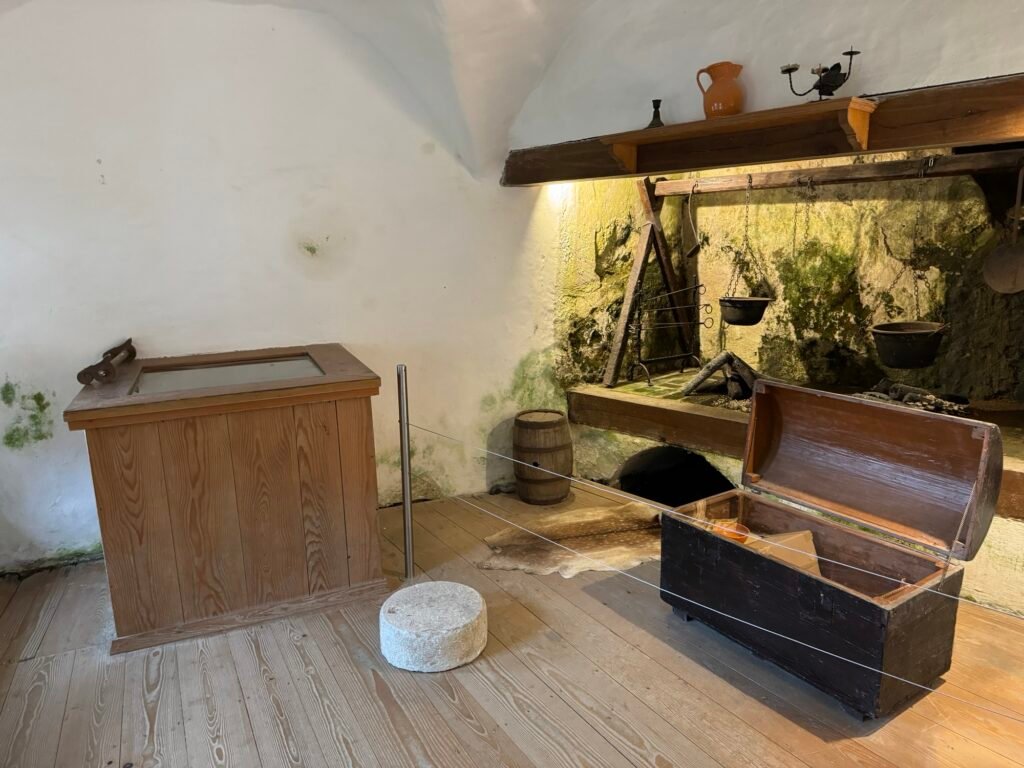
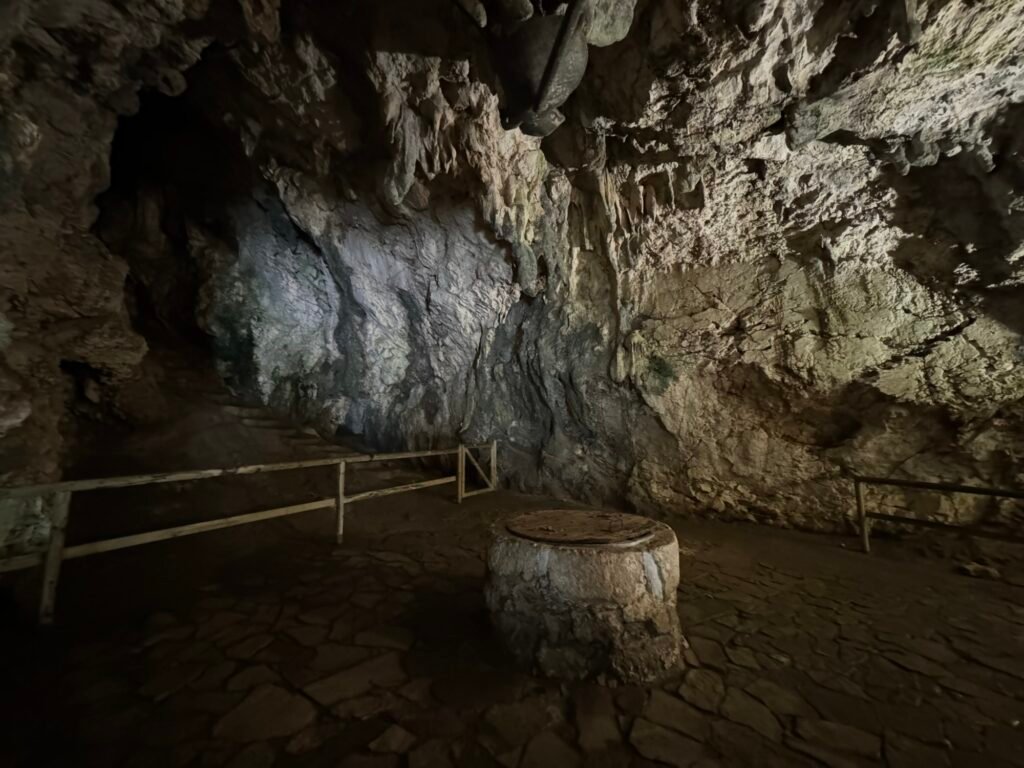
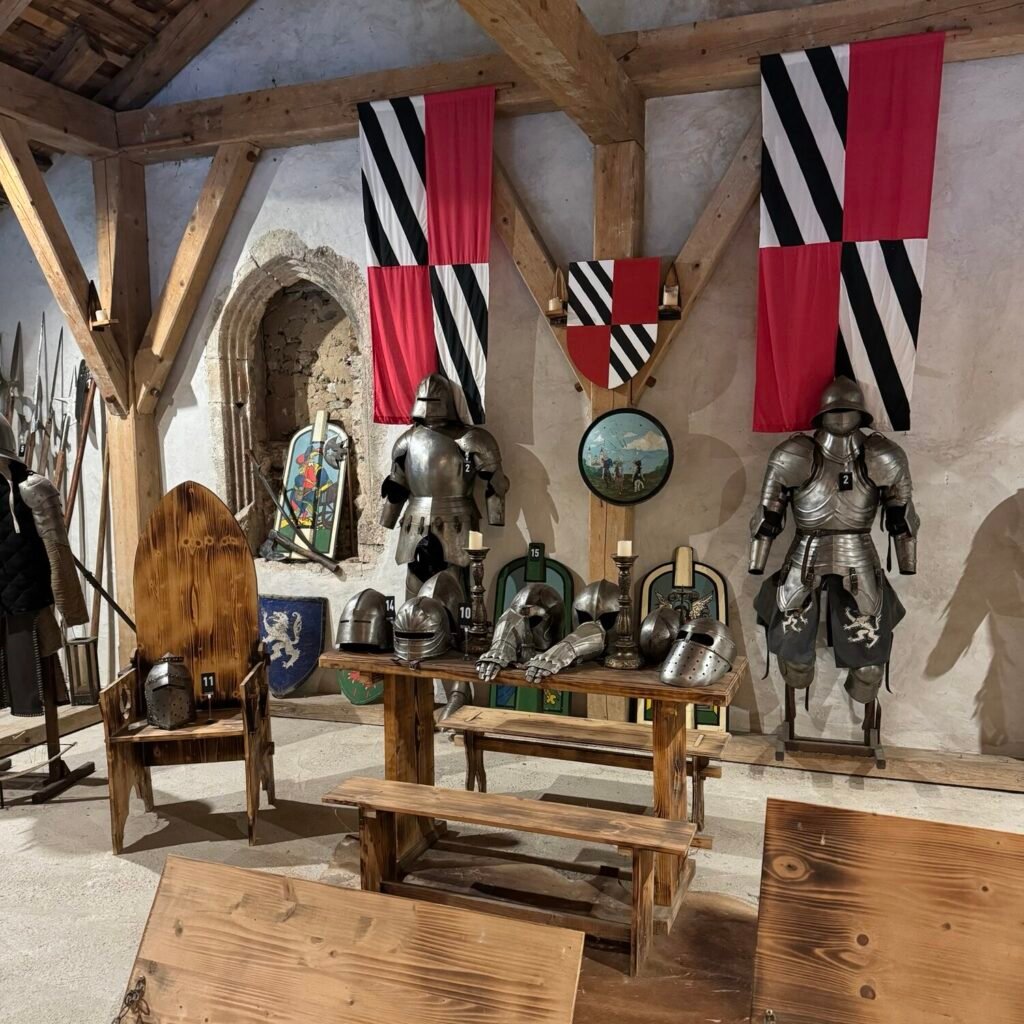

After exploring the castle, we took a quick lunch break at the visitor center. It was a simple but satisfying pause that allowed us to reflect on the morning’s awe-inspiring experience. The one-hour drive back to Ljubljana offered us a final opportunity to soak in Slovenia’s picturesque landscapes, a fitting farewell to a country that had captivated us at every turn. In Ljubljana, we returned our rental car before boarding a bus to Zagreb, Croatia. For us, this marked the end of a wonderful Slovenian chapter as we transitioned to the next part of our journey.
Where To Eat Near Predjama Castle
- Lunch: A quick sandwich at the Predjama visitor center given our time constraint. For those with more time, consider dining at Predjamska Gostilnica near the castle for a more leisurely meal- it has positive reviews for its traditional Slovenian dishes and great views of the castle.

Travel Tips For Visiting Predjama Castle
- Predjama Castle: Allocate at least 1.5–2 hours for the visit to fully explore the castle and its surroundings. Audio guides are available and provide fascinating insights into its history.
- Timing: Plan your visit early in the day to avoid crowds and allow ample time for the drive back to Ljubljana and ensure you have enough time for your onward journey.
Final Thoughts
Looking back on our 8-day journey through Slovenia, we were filled with gratitude for its stunning landscapes, rich history, and the warm hospitality we encountered. Every moment, from exploring fairytale lakes to walking through medieval streets, had left a lasting impression. Slovenia was not just a destination—it was an experience that deeply inspired us and left us yearning to return someday.
With More Time
If you have more time to explore Slovenia, consider adding these experiences to your itinerary:
- Extend Time at Triglav National Park (+1-3 days)
- Where/When to Add: Add one to three days between Day 4 (Vintgar Gorge and Lake Bled) and Day 5 (Lake Bohinj). Spend the additional days hiking in Triglav National Park, visiting locations like the Seven Lakes Valley, exploring alpine trails near Bohinj, or venturing to the Soča River Valley for activities like kayaking, rafting, or hiking along the emerald-green river.
- Enjoy a Night in Kranjska Gora (+1 day)
- Where/When to Add: Add Kranjska Gora between Day 4 (Vintgar Gorge and Lake Bled) and Day 5 (Lake Bohinj). Spend a night in this charming alpine town to enjoy its stunning mountain views, serene hiking trails, or simply relax in a peaceful environment.
- Stay Longer in Piran (+1-2 day)
- Where/When to Add: Add an extra day or two after Day 7 to explore more of Piran and other nearby coastal towns, such as Izola and Koper. Wander the picturesque streets of Izola, explore Koper’s historic charm, take a coastal walk, or visit local wineries for a taste of Slovenian coastal life.
- Explore Postojna Cave (+1 day)
- Where/When to Add: Combine the visit to Postojna Cave with Day 8, which already includes Predjama Castle. Start the day early and visit Postojna Cave first (allow 2–3 hours), as it’s only about 10 minutes from Predjama Castle. Afterward, continue to Predjama Castle as planned. Stay in Ljubljana overnight, then depart Slovenia the following day.
- Discover Maribor (+2 days)
- Where/When to Add: Head to Maribor directly from Predjama Castle on Day 8 and stay there for two nights. Known as Slovenia’s wine capital, Maribor offers highlights such as the historic Old Vine House, home to the world’s oldest grapevine, and the scenic Lent district along the Drava River. Explore local wineries, enjoy riverside strolls, and take in the city’s cultural and culinary offerings. Depending on your onward travel plans, you can either return to Ljubljana to depart Slovenia or depart directly from Maribor if it suits your route.
With Less Time
If your schedule is tighter, here are ways to streamline the itinerary while still experiencing Slovenia’s highlights:
- Skip Piran (-1 day)
- If coastal experiences aren’t a priority, skip Piran (Day 7) and focus on inland highlights like Lake Bled, Bohinj, and Predjama Castle. This change allows for more time in Slovenia’s alpine and historical regions.
- Condense Lake Bled, Vintgar Gorge and Lake Bohinj (-1 day)
- Pick up your rental car on the evening of Day 2 to ensure an early start on Day 3. Begin with a morning hike to both the Ojstrica and Mala Osojnica viewpoints, followed by a visit to the Church of the Assumption on Bled Island. In the afternoon, explore Vintgar Gorge. On the following day, jump to Day 5 of the itinerary and visit Lake Bohinj.
- Alternatively, focus on Lake Bled (Ojstrica, Mala Osojnica, and the Church of the Assumption) on Day 3. Then on Day 4, explore Vintgar Gorge in the morning and Lake Bohinj in the afternoon.
- These adjustments condense three days (Days 3, 4, and 5) into two, covering all major attractions without omissions. However, be aware that this itinerary is quite rushed, requires a high fitness level, and deviates from the mid-paced travel philosophy central to this blog. I only recommend this option if you’re very tight on time and don’t want to skip any highlights.
Other Frequently Asked Questions
How to Get to Slovenia
There are multiple ways to reach Slovenia, and you can choose the method that best suits your preferences and travel plans.
- By Air:
Flying to Ljubljana Jože Pučnik Airport (LJU) is the most popular option for international travelers. The airport offers direct flights to major European cities, including Frankfurt, Paris, London, Zurich, and Brussels. This is the quickest and most convenient way to reach Slovenia, especially from further afield. - By Car:
Slovenia’s well-maintained highways make driving an excellent option for travelers from neighboring countries. Slovenia shares borders with Austria (north), Italy (west), Hungary (northeast), and Croatia (south and southeast). Many visitors incorporate Slovenia into a broader European road trip, enjoying scenic routes through the Alps or the countryside. - By Bus:
Buses are a reliable, affordable, and popular choice, particularly for regional travelers. For example, direct bus services from Zagreb to Ljubljana offer a convenient and scenic way to arrive in Slovenia. Buses also connect Slovenia to other nearby cities in Austria, Italy, and Hungary. - By Train:
Slovenia’s rail network connects to neighboring countries like Austria, Italy, and Croatia, making it a sustainable travel option. However, trains are generally slower and less frequent than buses or driving, so they are better suited for travelers prioritizing comfort over speed.
Getting Around Slovenia
Navigating Slovenia is straightforward, whether by car or public transportation. Here’s what you need to know:
By Car
Driving is our highly recommended way to explore Slovenia. During our 8-day Slovenia road trip, we found driving in Slovenia a very pleasant experience, thanks to its well-maintained roads and courteous drivers. The country’s infrastructure is excellent, with clear signage and orderly traffic. Motorists adhere to traffic rules, making the driving environment safe and predictable.
Key Points:
- Road Conditions: Highways and local roads are in excellent condition, facilitating smooth travel across the country.
- Signage: Road signs are clear and follow international standards, aiding navigation even for first-time visitors.
- Driver Behavior: Slovenian drivers are known for their politeness and adherence to traffic laws, contributing to a stress-free driving experience.
Additional Tips:
- Speed Limits: Adhere to posted speed limits: 50 km/h in urban areas, 90 km/h on open roads, and 130 km/h on highways.
- Vignette Requirement: A toll vignette is mandatory for driving on Slovenian highways. These can be purchased at gas stations, post offices, or online.
- Equipment: Ensure your vehicle is equipped with the necessary safety gear, such as a warning triangle and reflective vest.
- Car Rentals: If you rent a car, most car rental companies will arrange the vignette and required equipment for you, and these costs are typically included in the total rental price. However, it’s a good practice to double-check with the rental company when picking up the car to confirm everything is in order.
By Public Transport
Slovenia boasts a reliable and extensive public transportation network, particularly buses, which connect major cities and tourist destinations.
Bus Routes Between Popular Tourist Spots:
- Ljubljana to Lake Bled: Frequent daily services operate between the capital and Lake Bled, with a journey time of approximately 90 minutes.
- Ljubljana to Postojna Cave and Predjama Castle: Regular buses run from Ljubljana to Postojna, from where local transport can take you to the cave and castle.
- Ljubljana to Piran (Adriatic Coast): Direct bus services connect Ljubljana to coastal towns like Piran, especially during the summer months.
Additional Tips:
- Schedules: Timetables are available online and at bus stations; it’s advisable to check them in advance, especially during weekends and holidays.
- Tickets: Purchase tickets at bus stations, directly from drivers, or online. Booking in advance is recommended during peak tourist seasons.
- Comfort: Buses are generally comfortable and punctual, offering a cost-effective way to explore Slovenia.
The End. Happy Traveling!
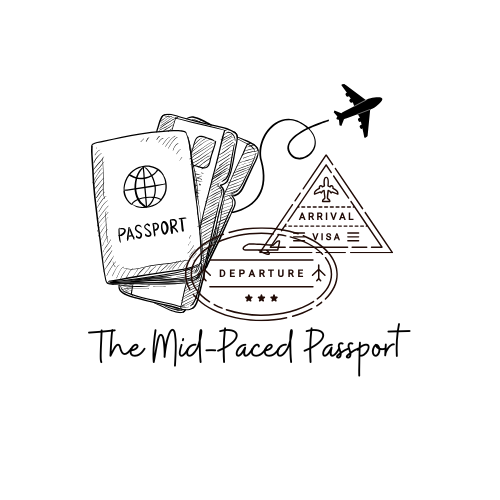



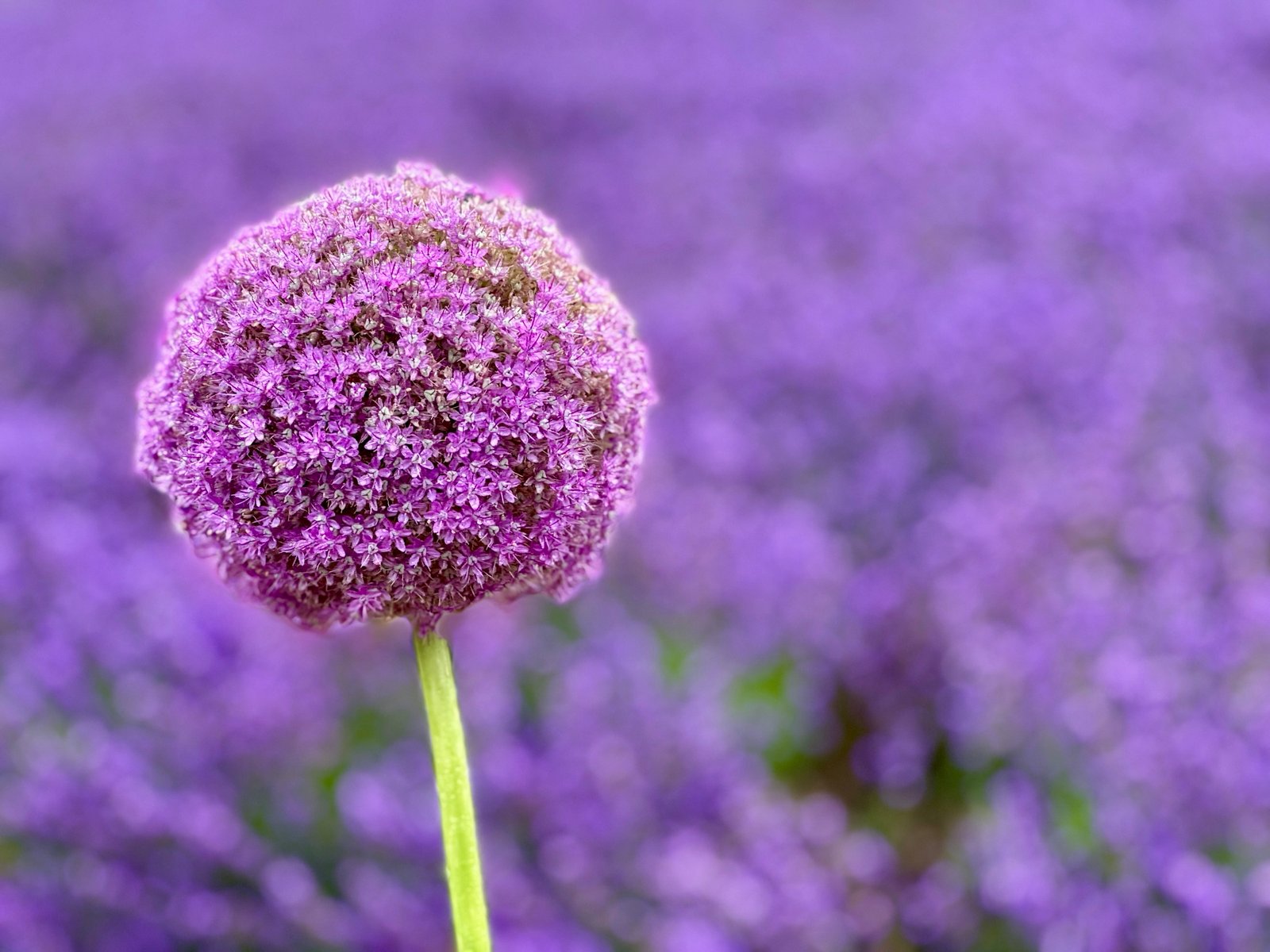

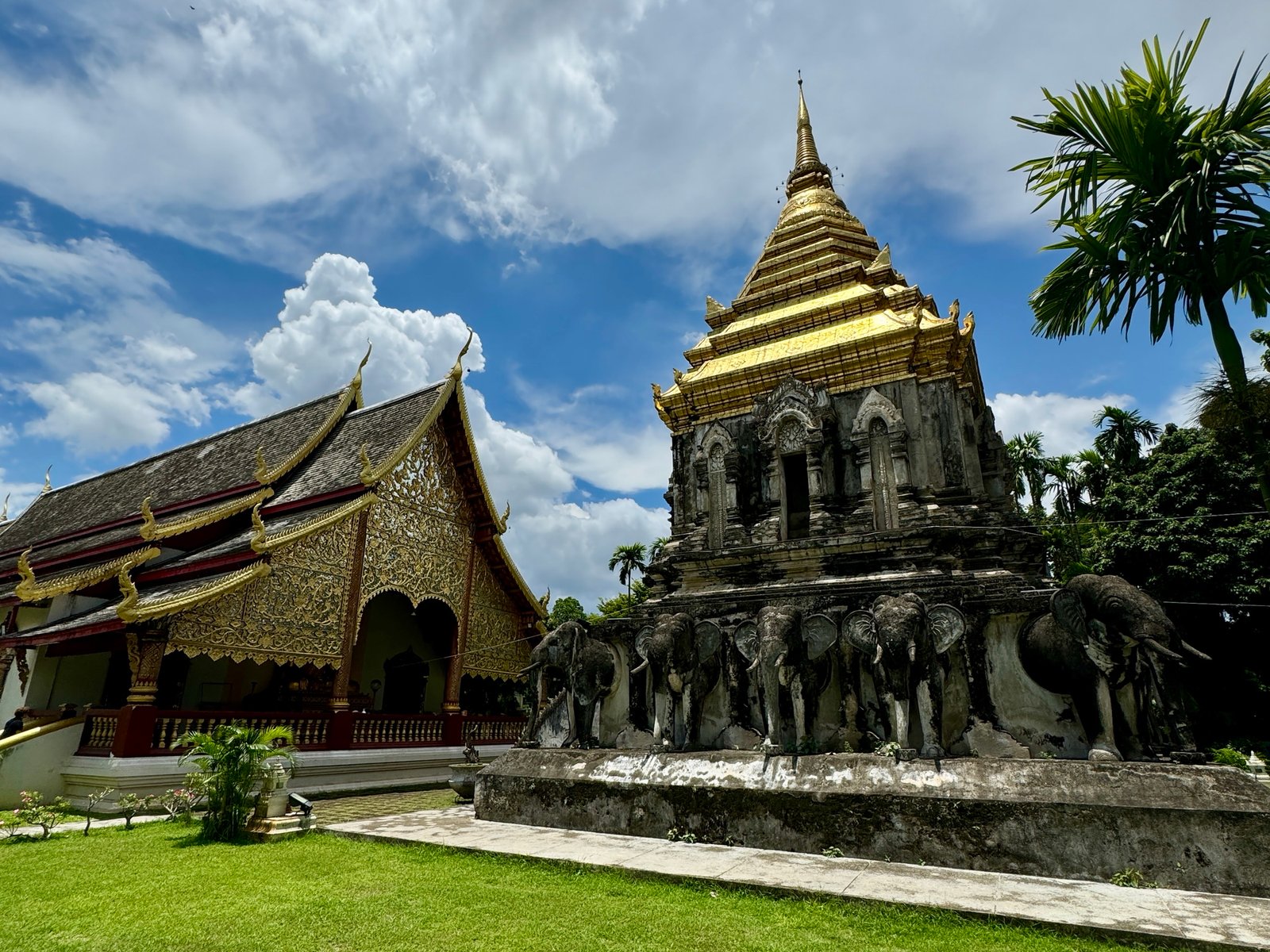
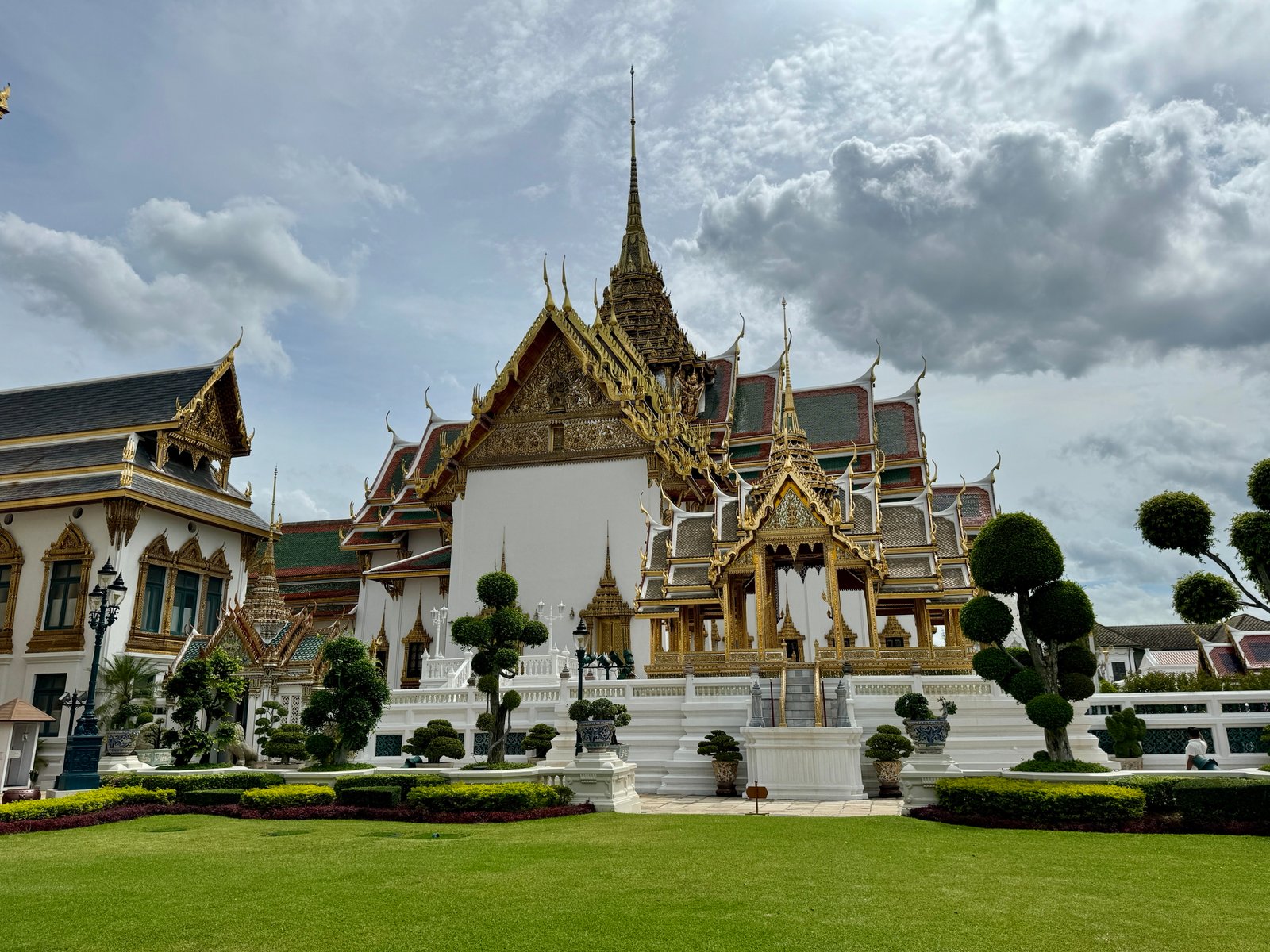
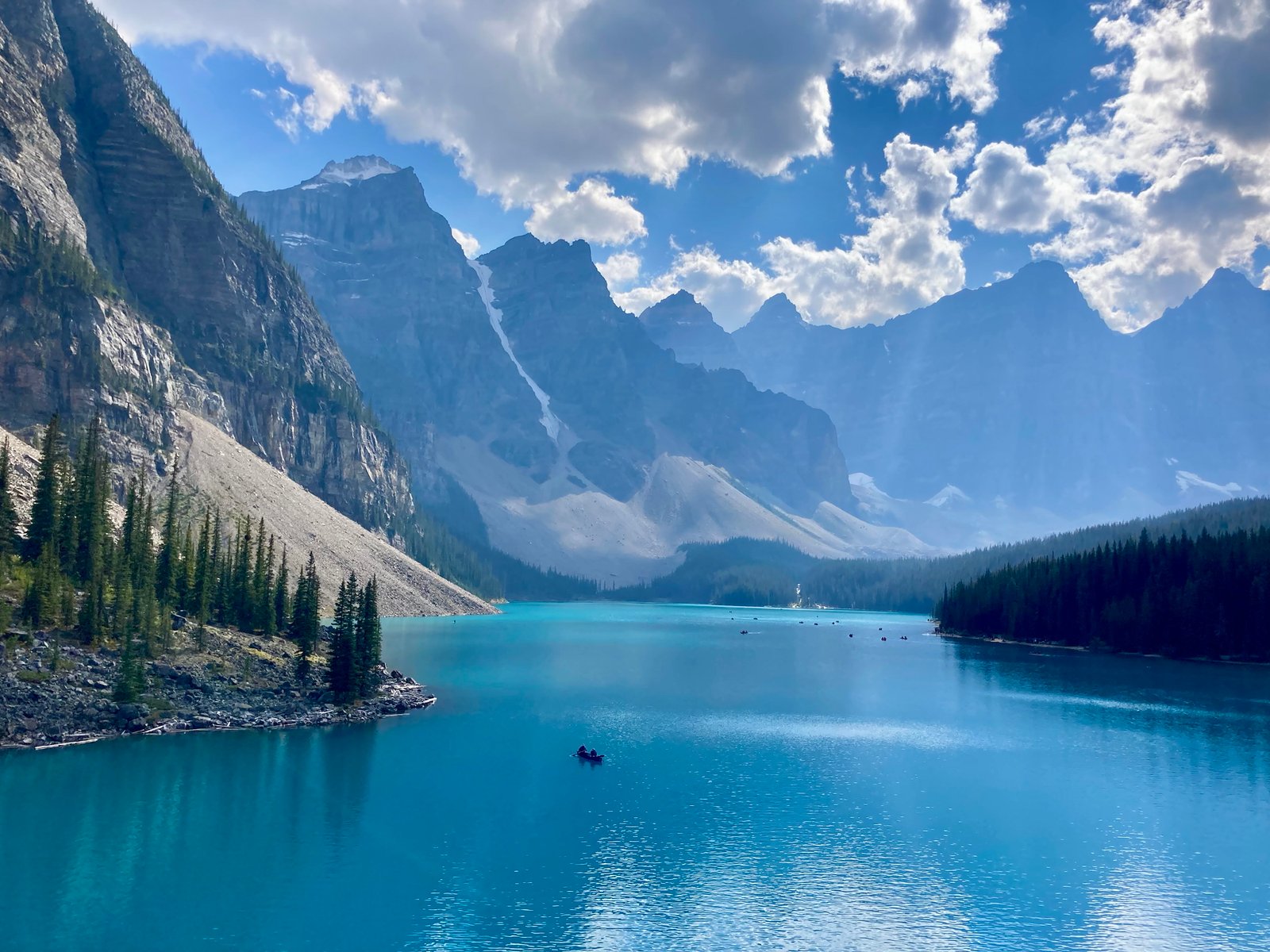
Leave a Reply